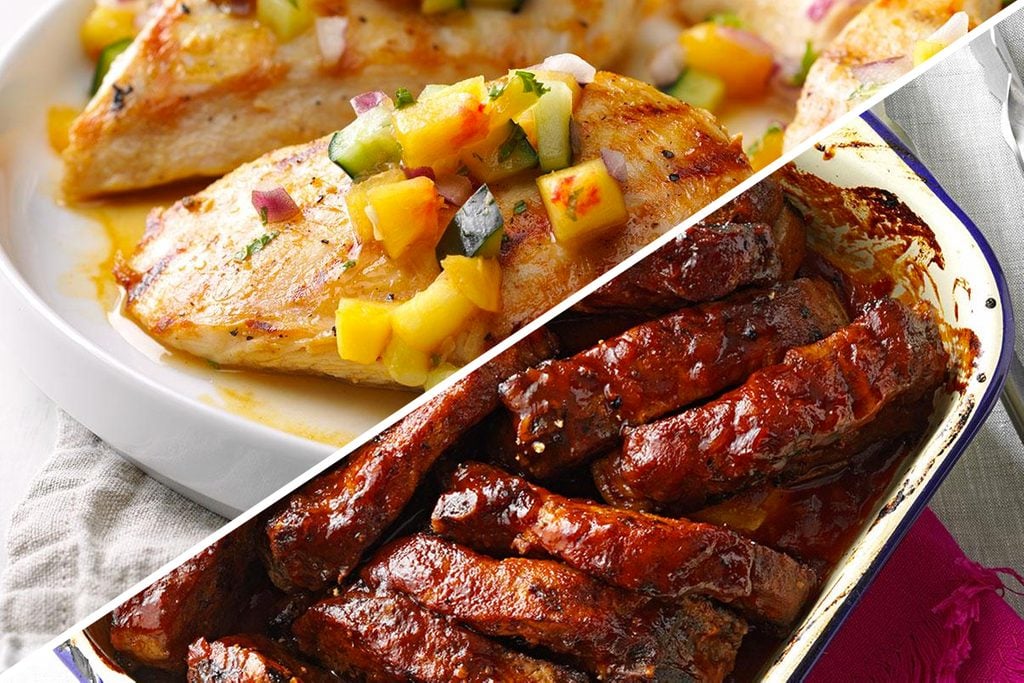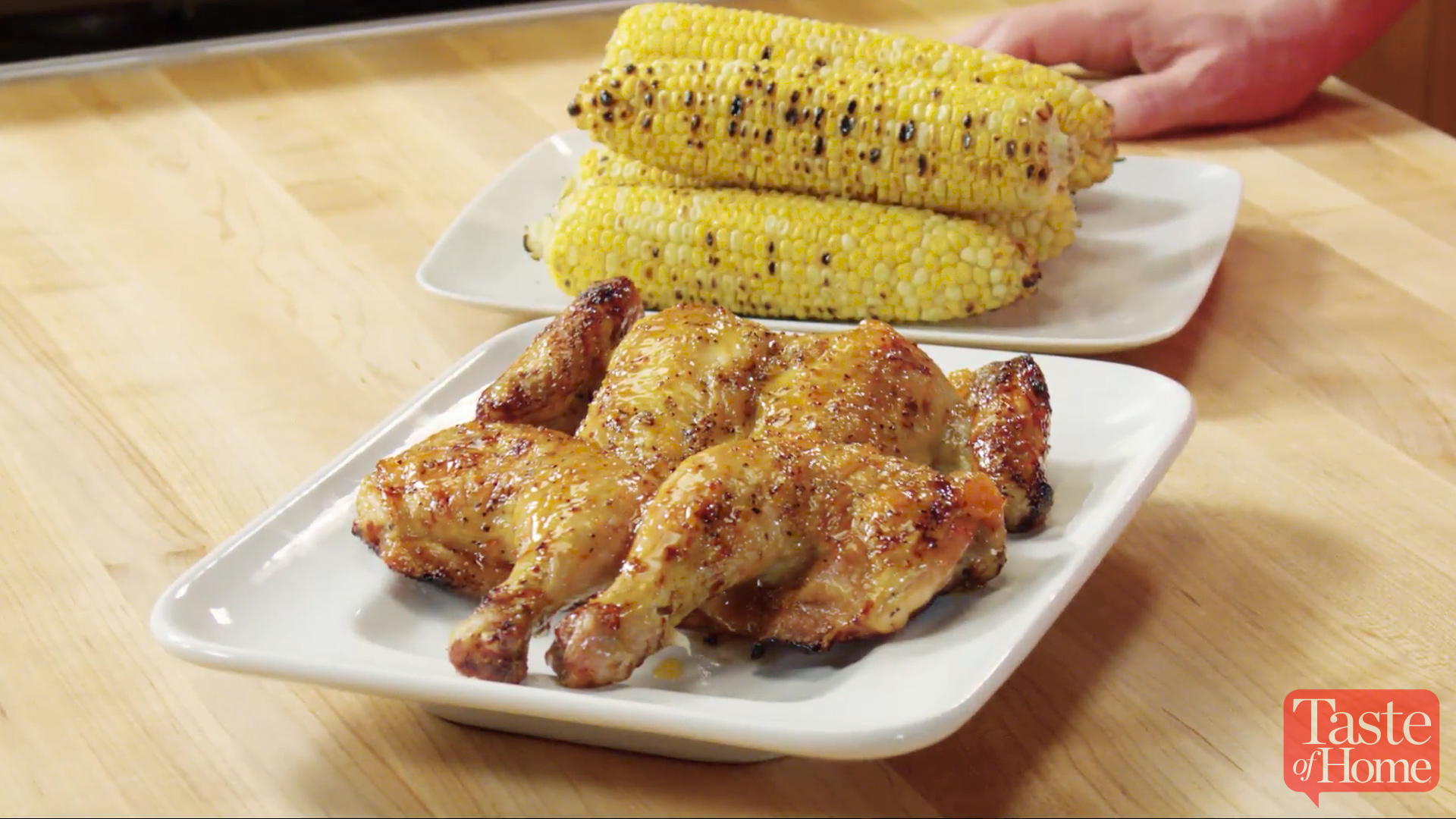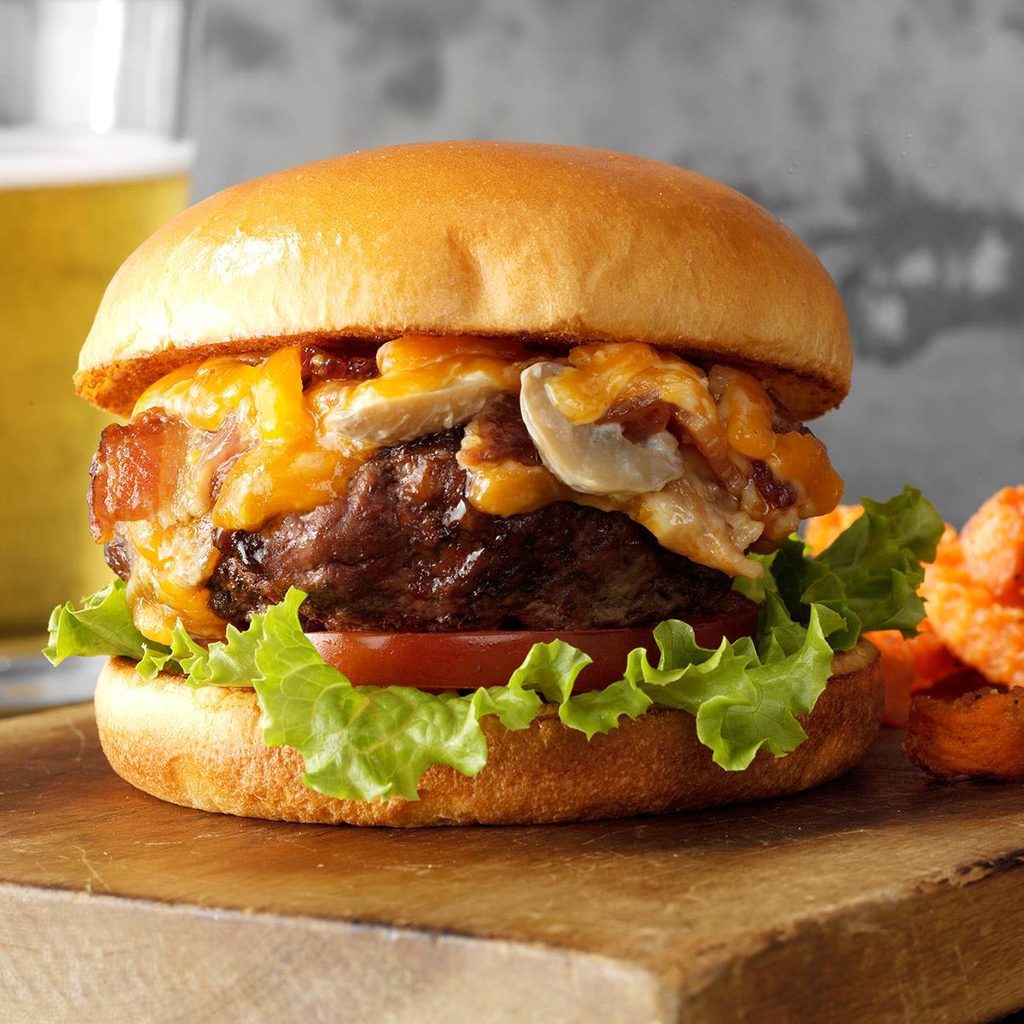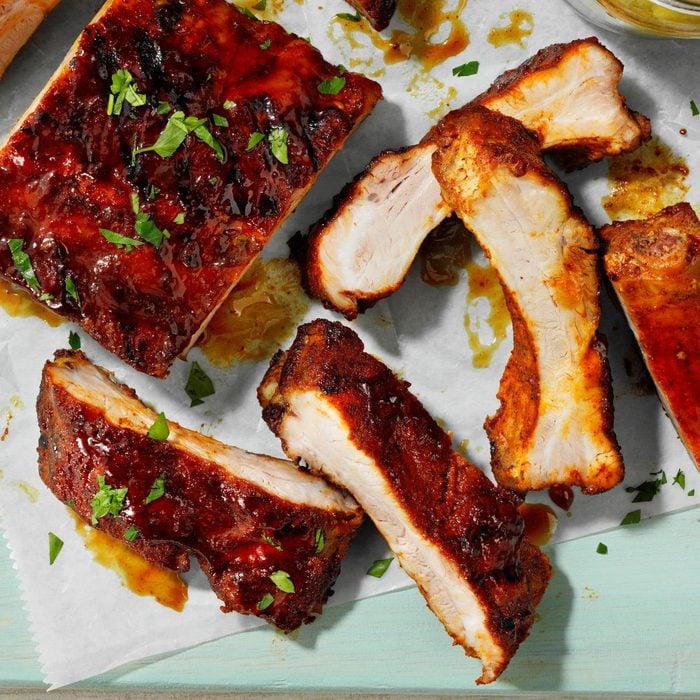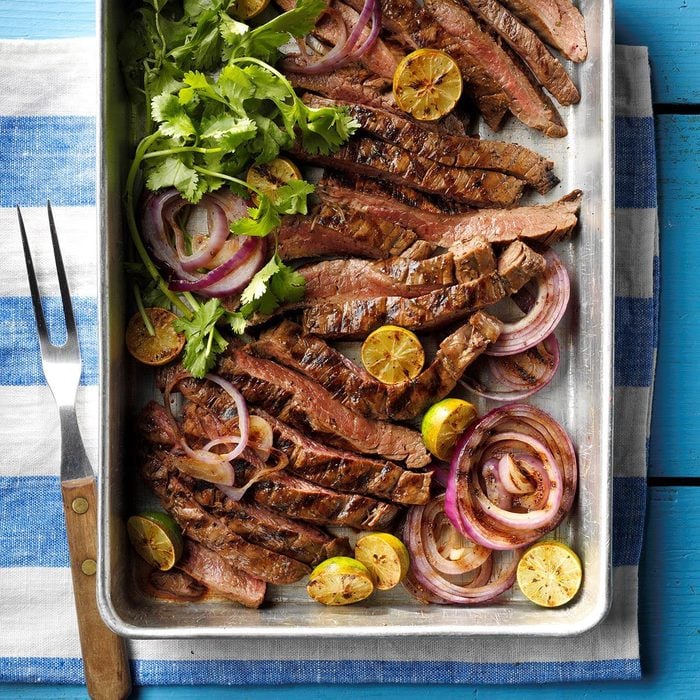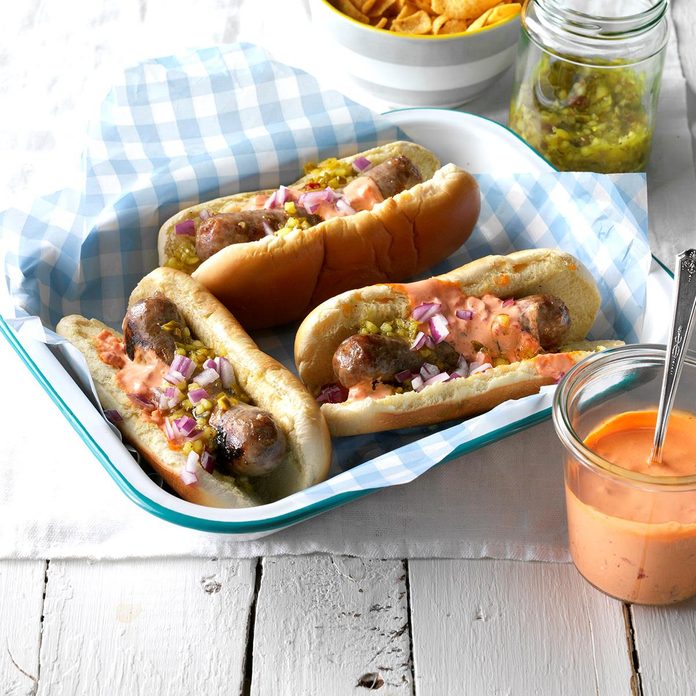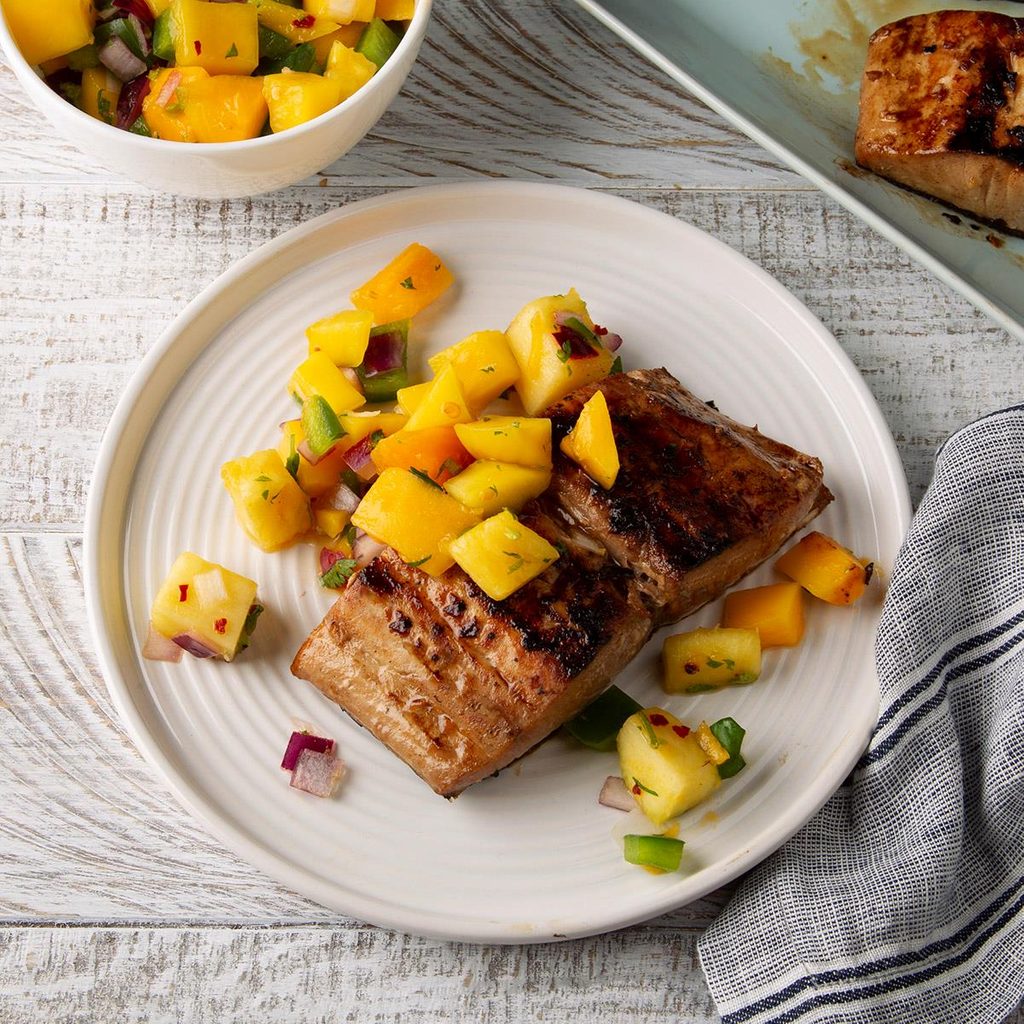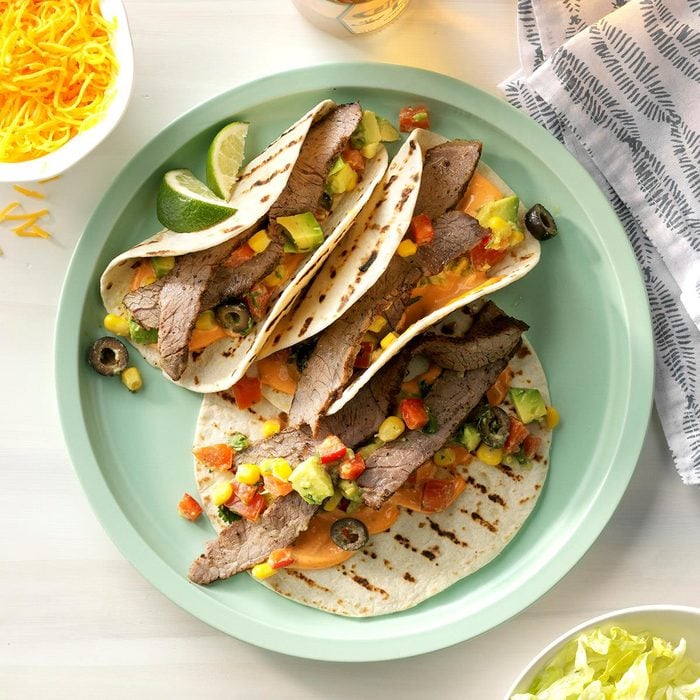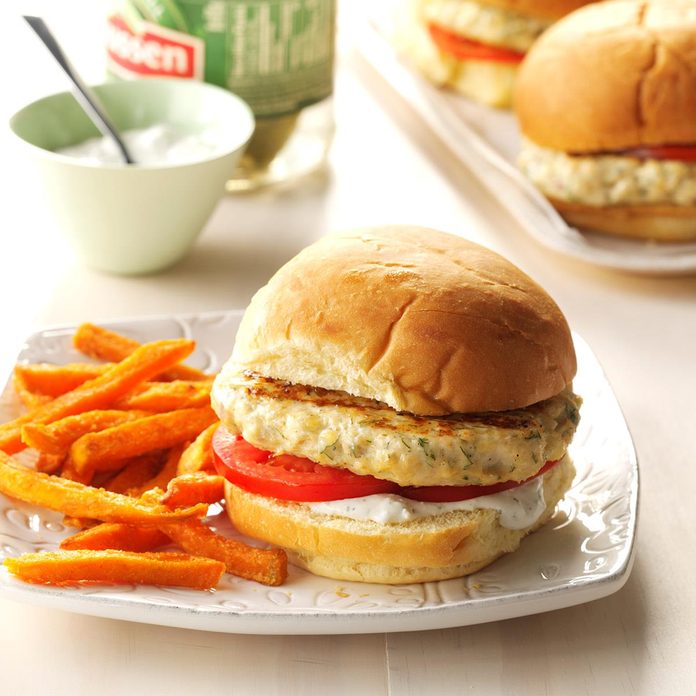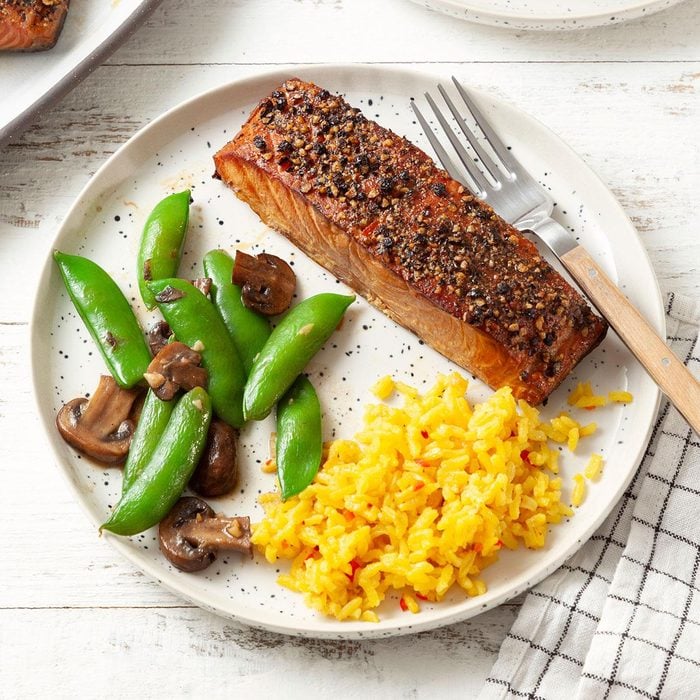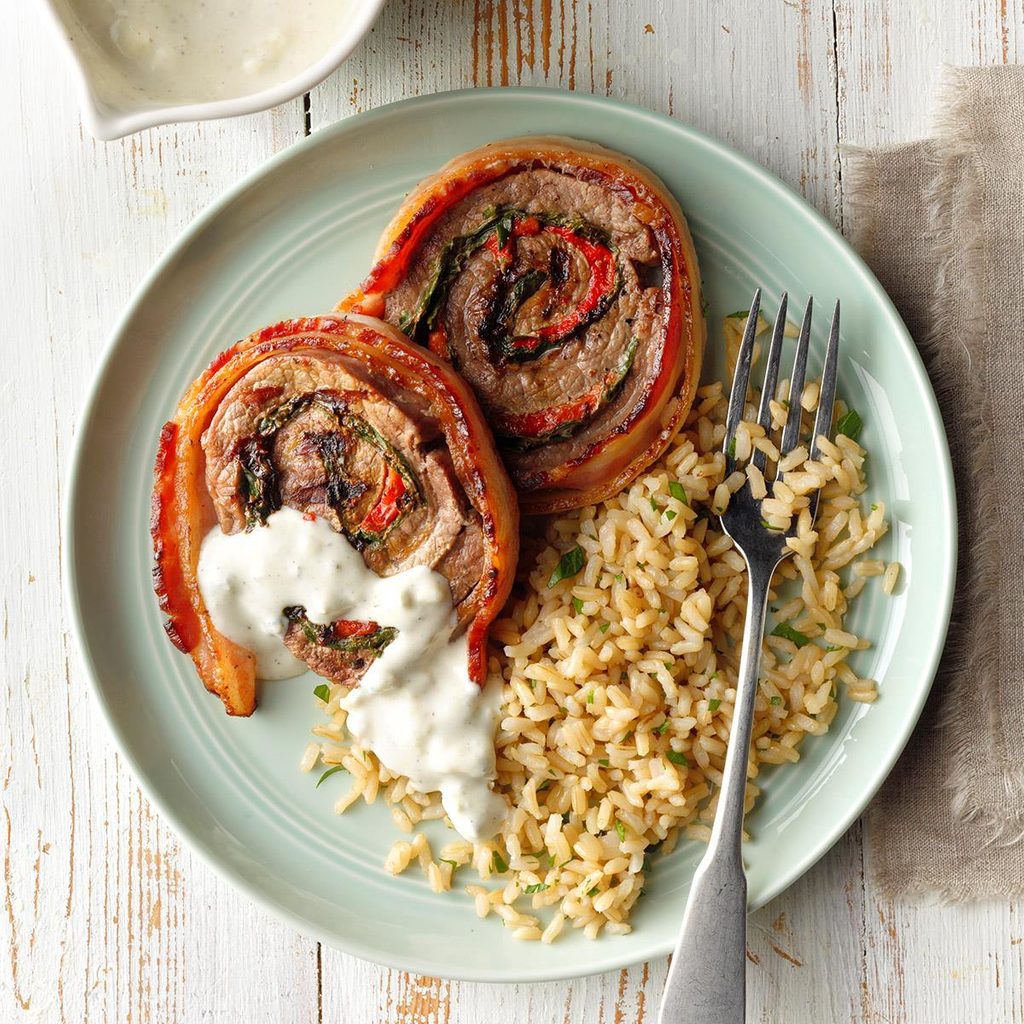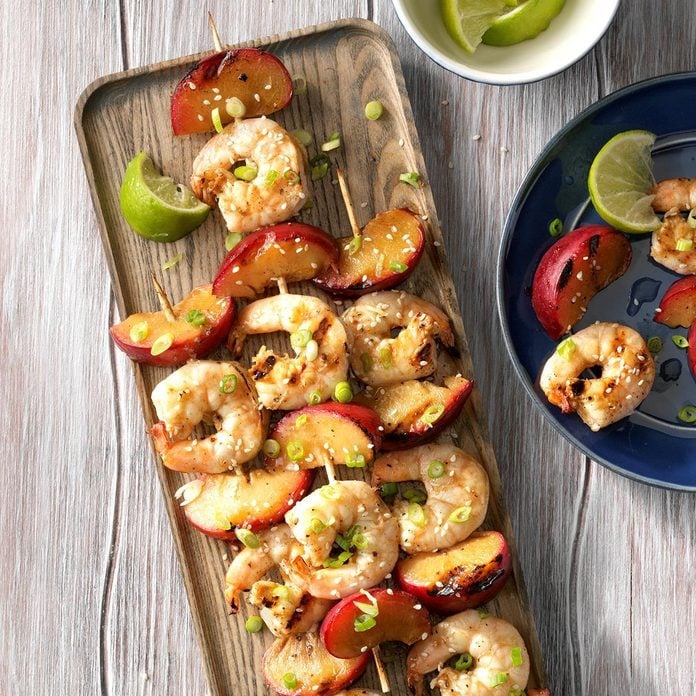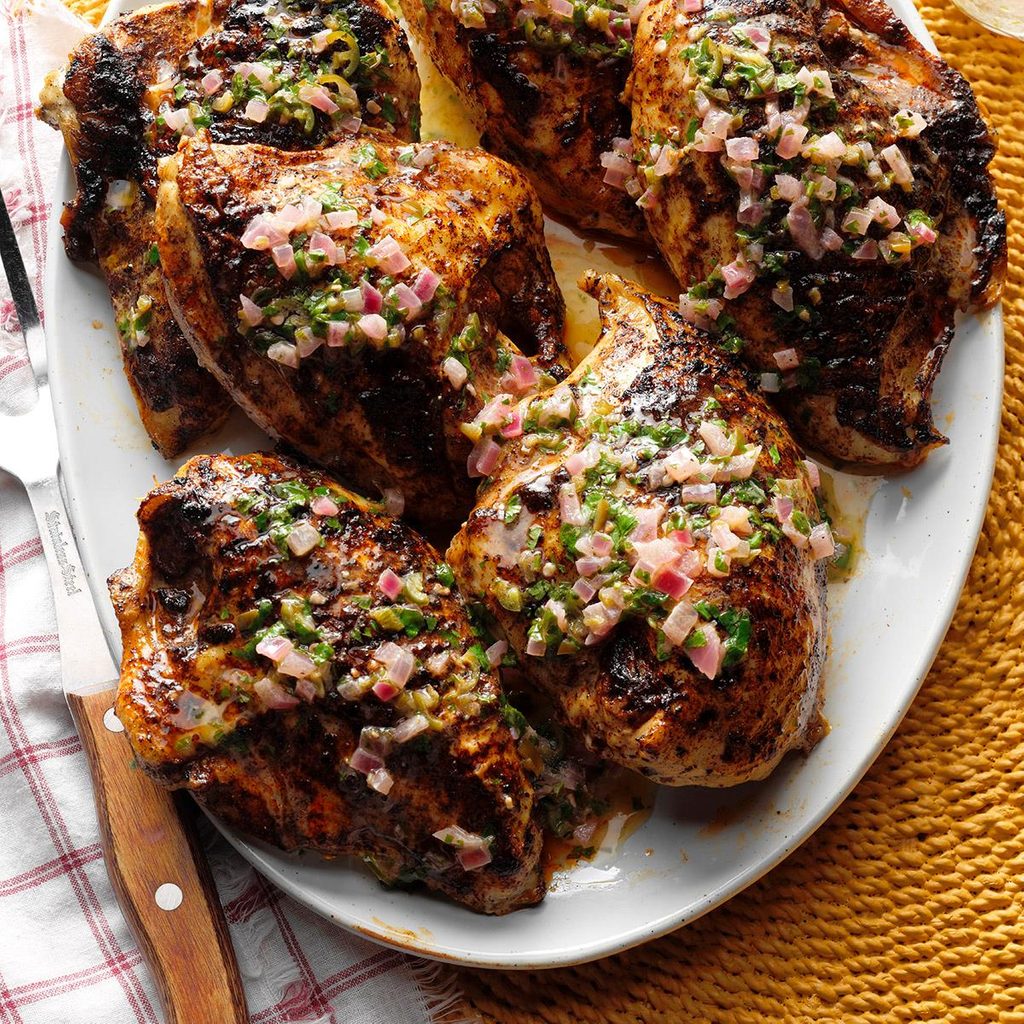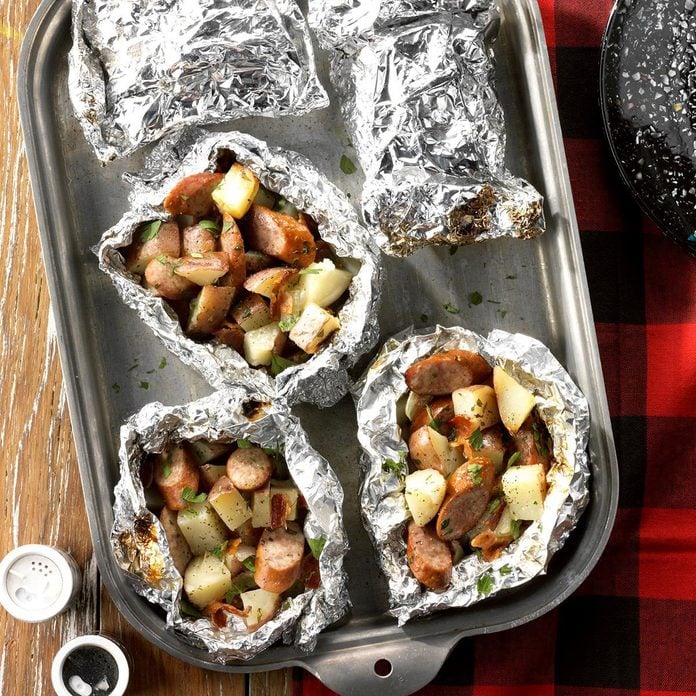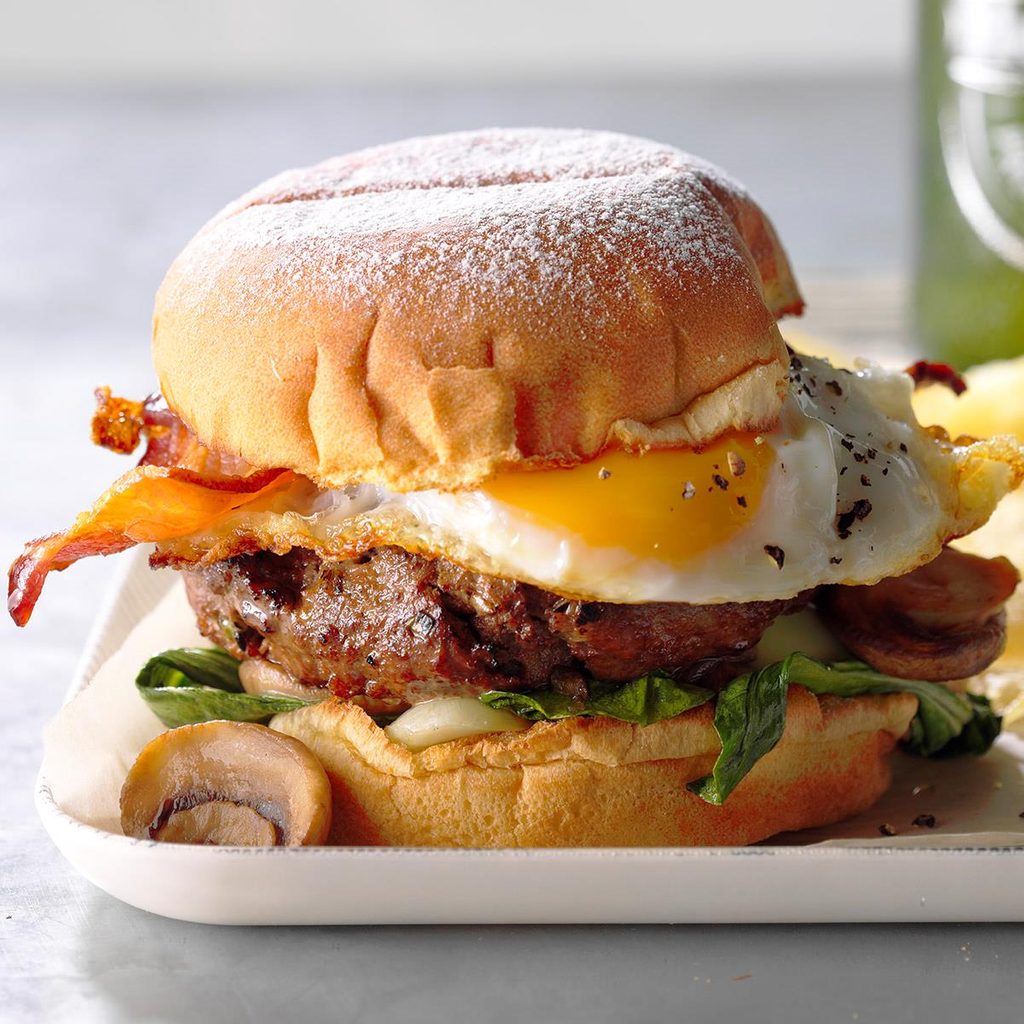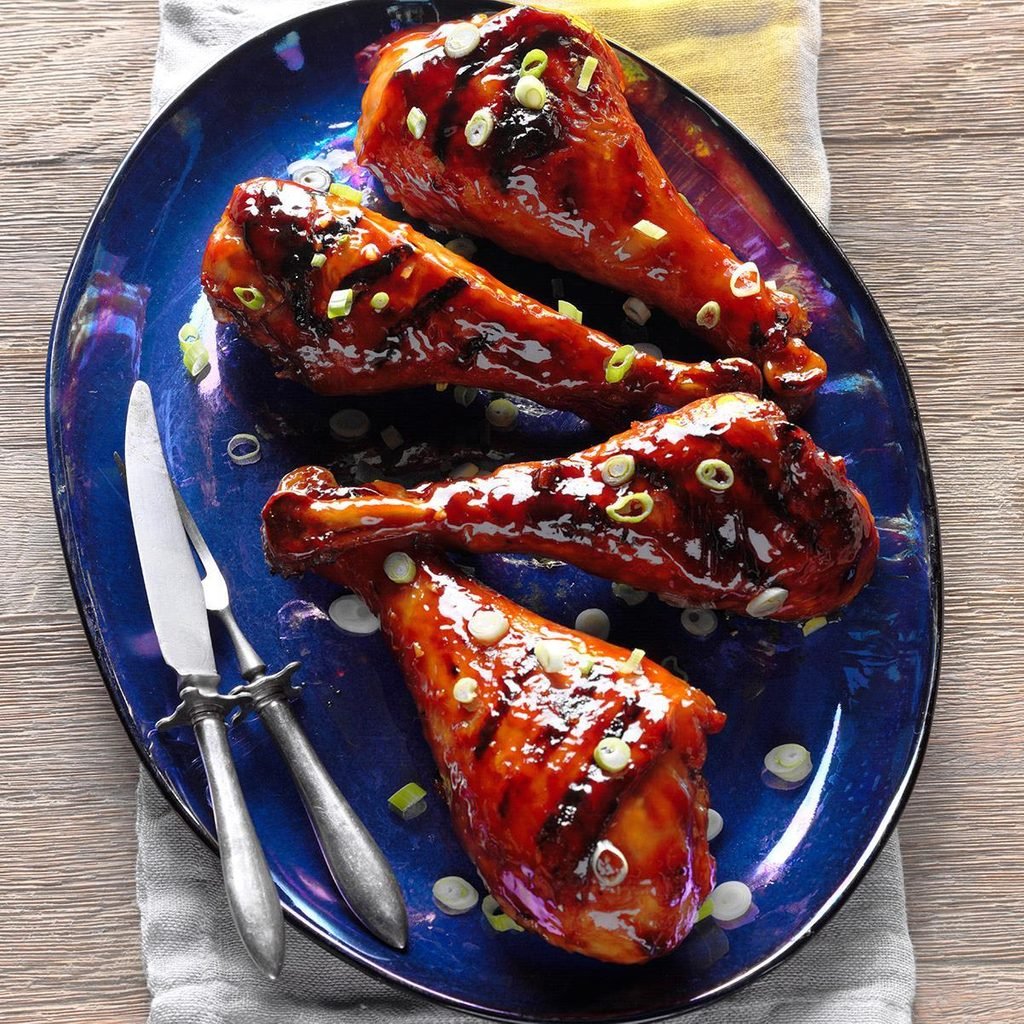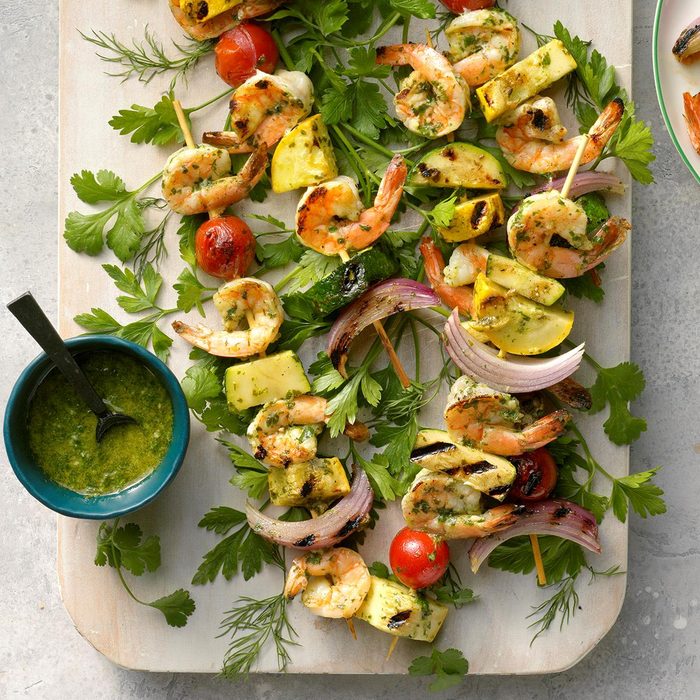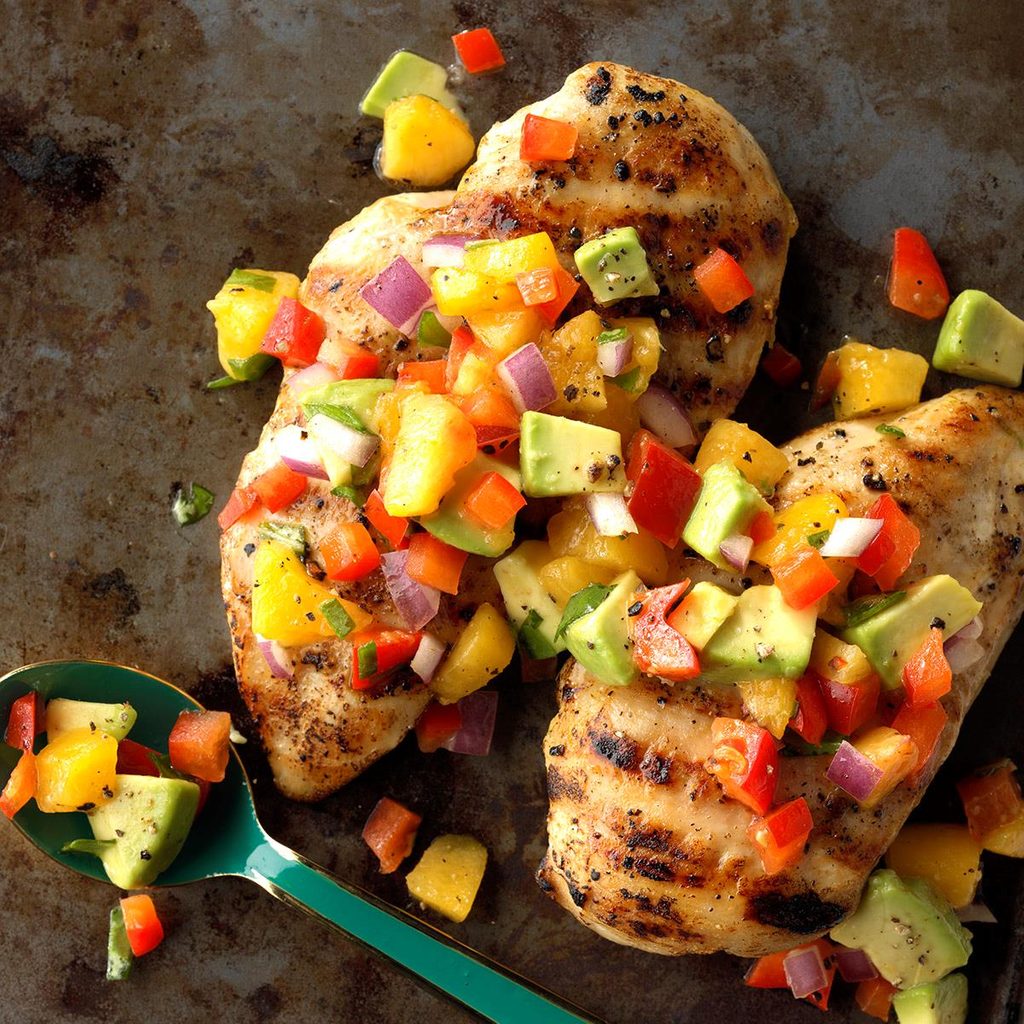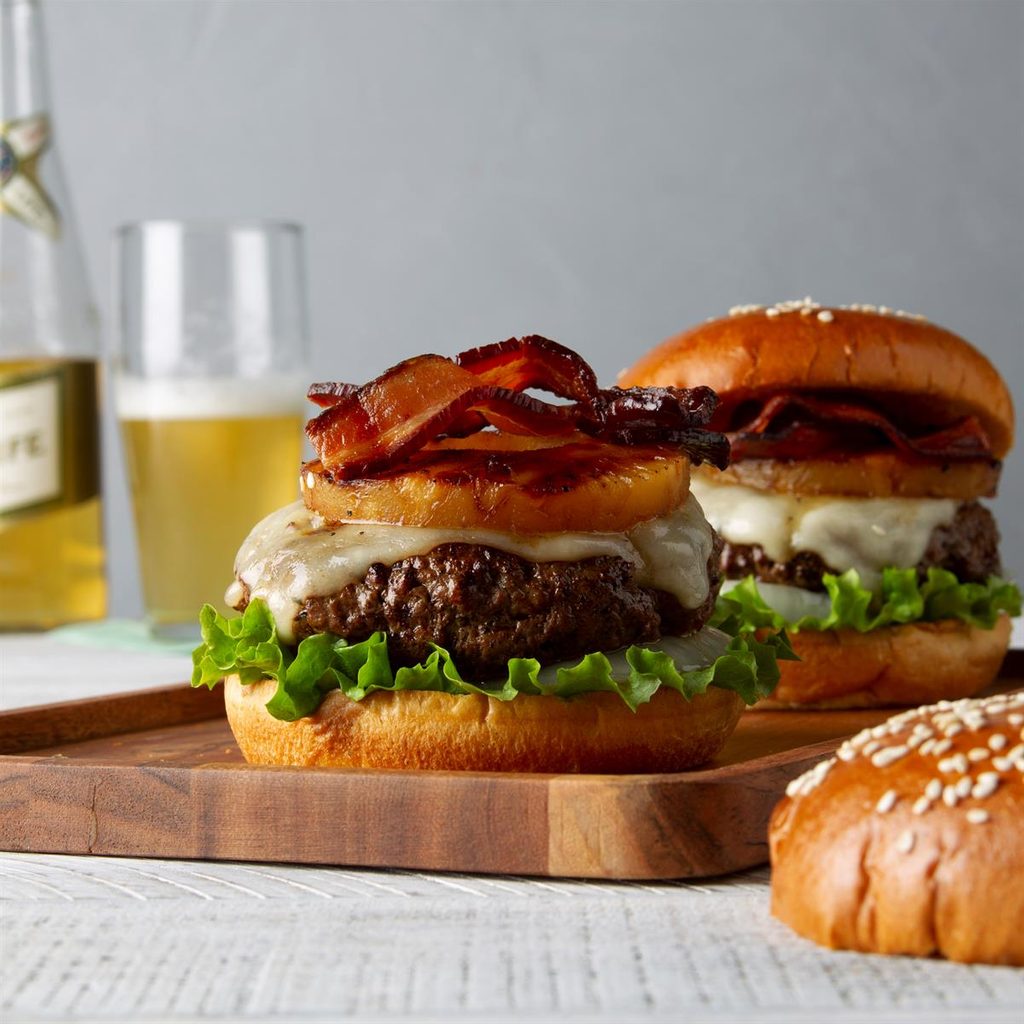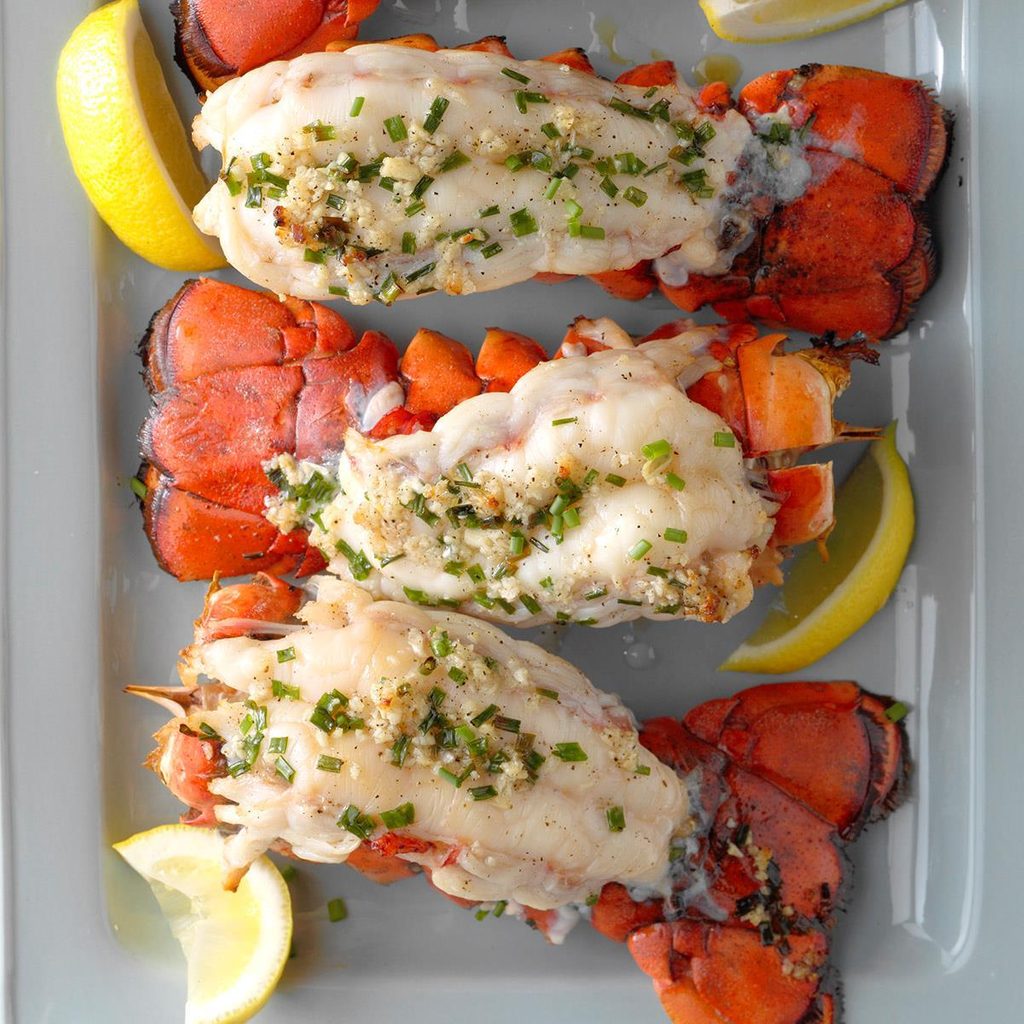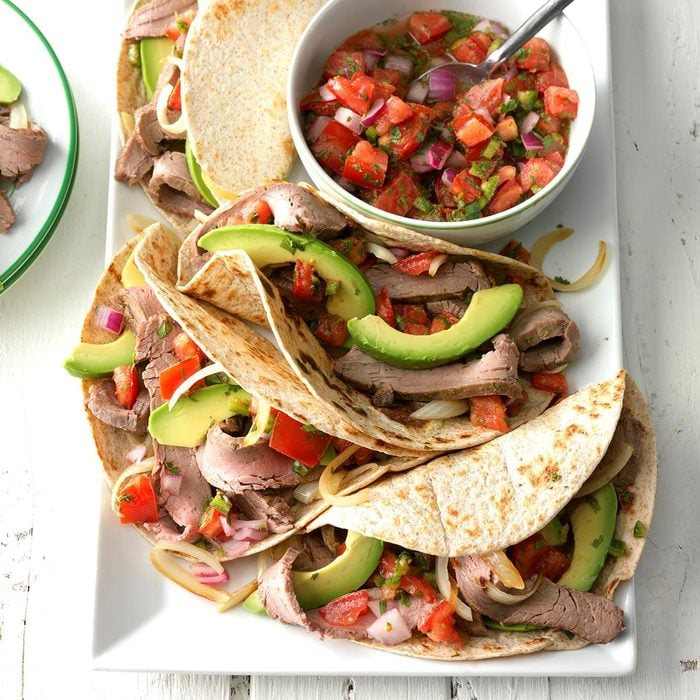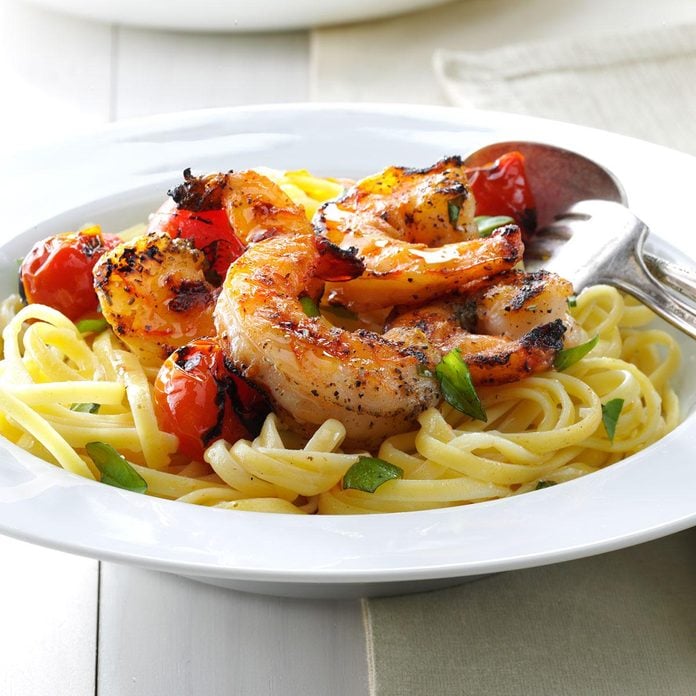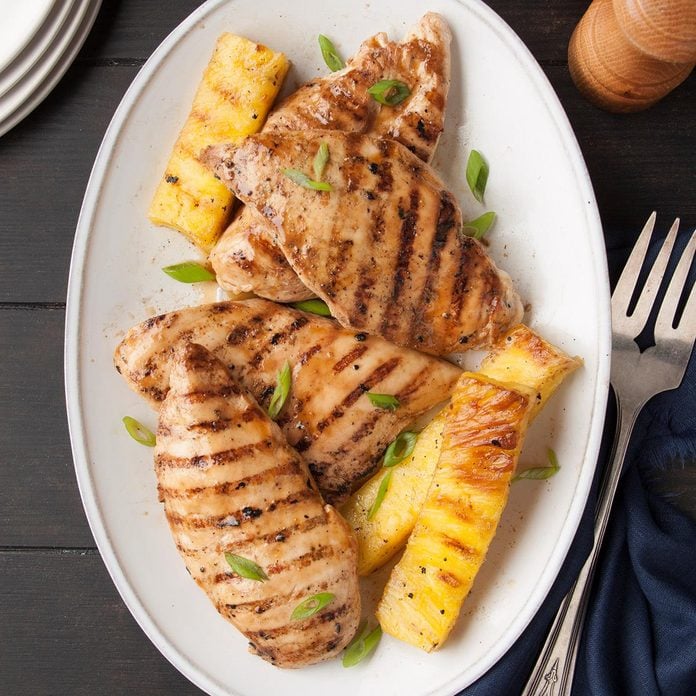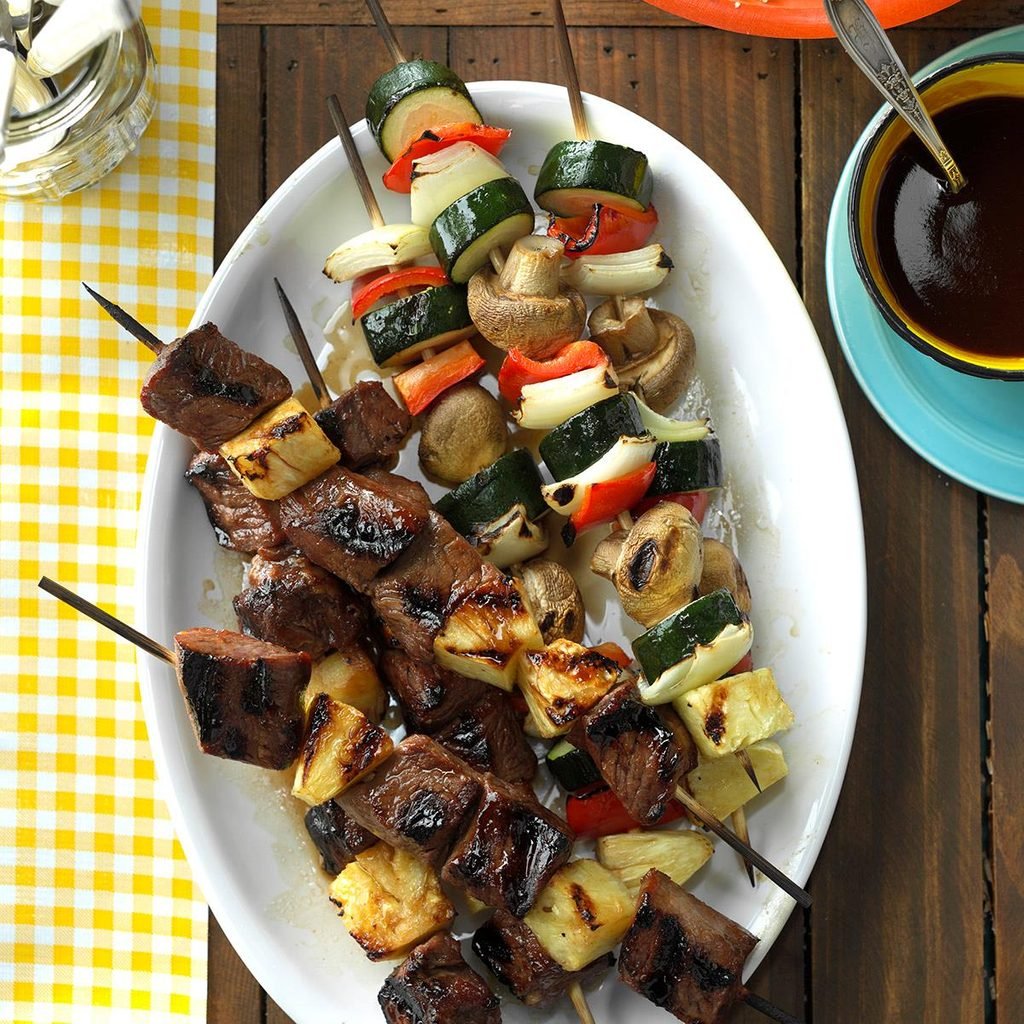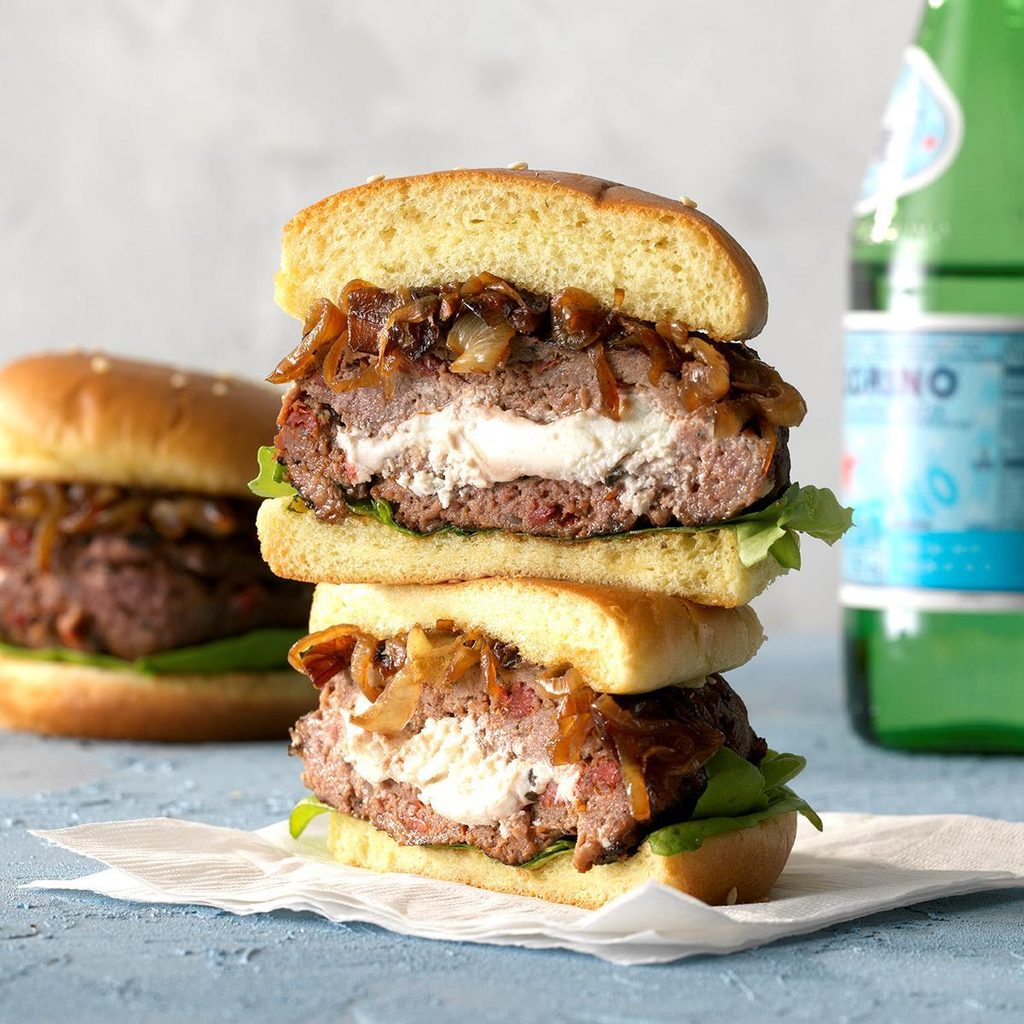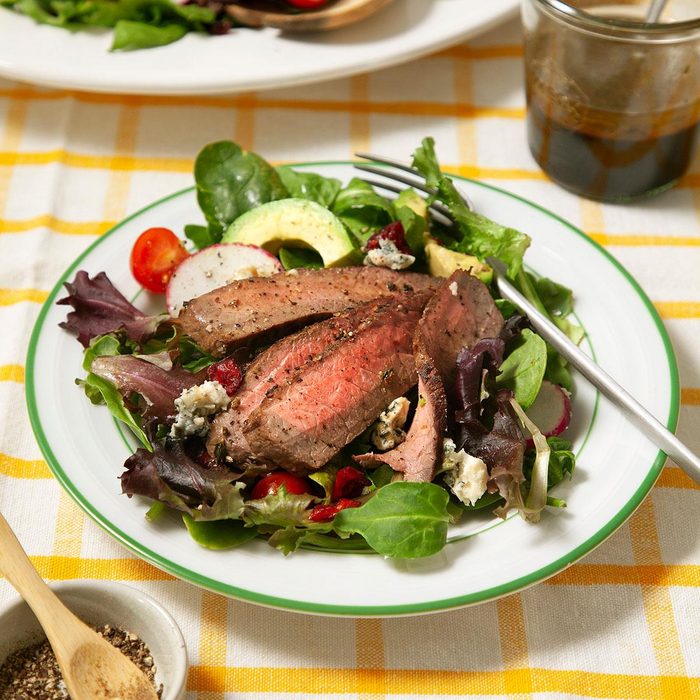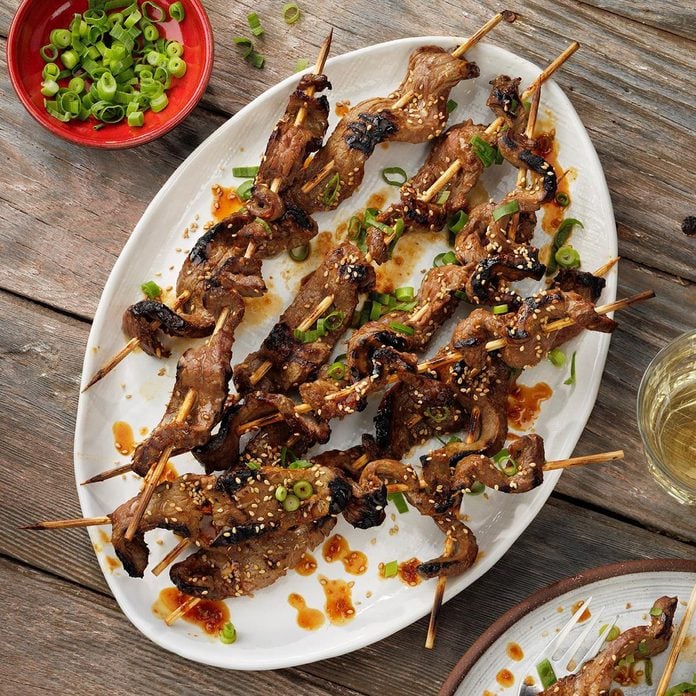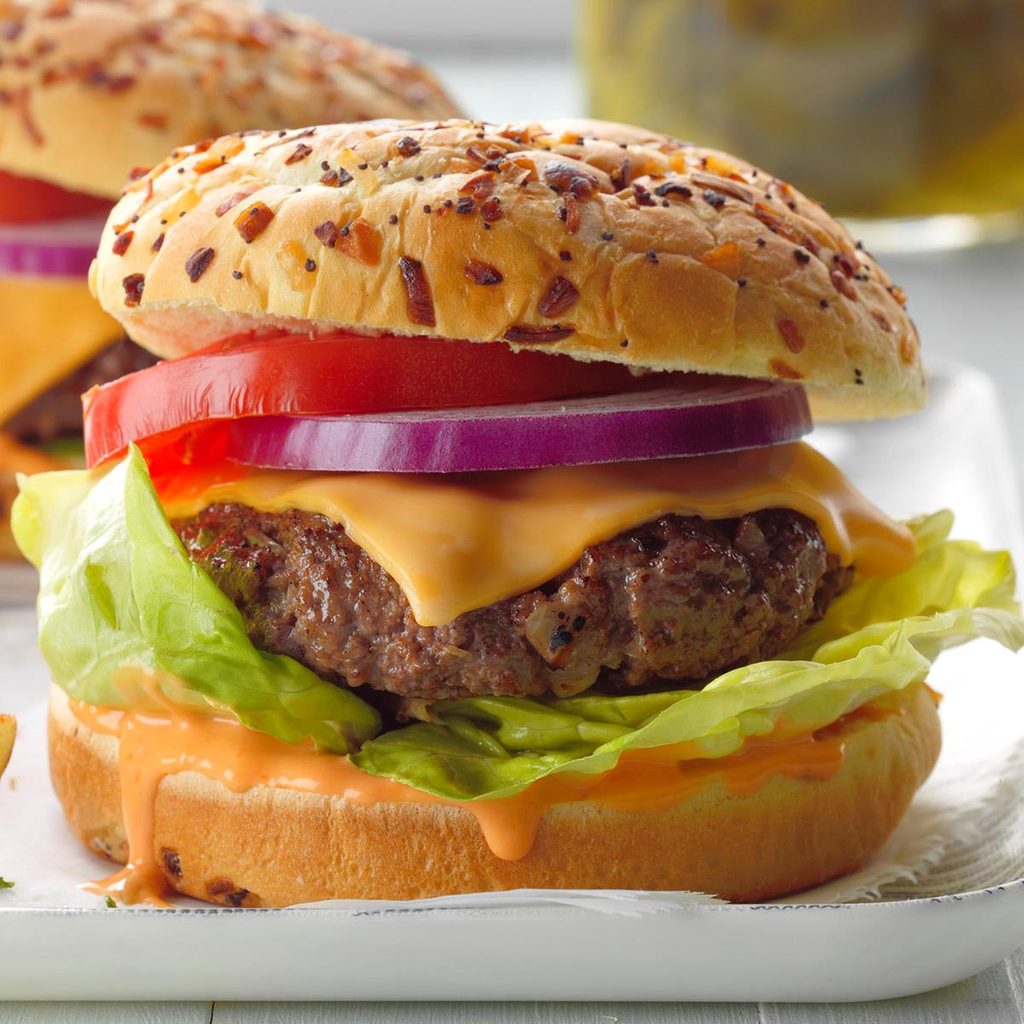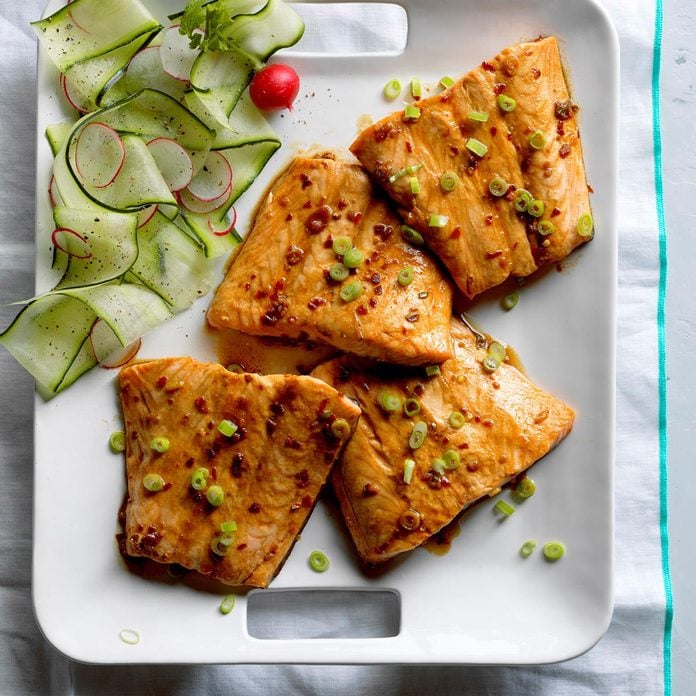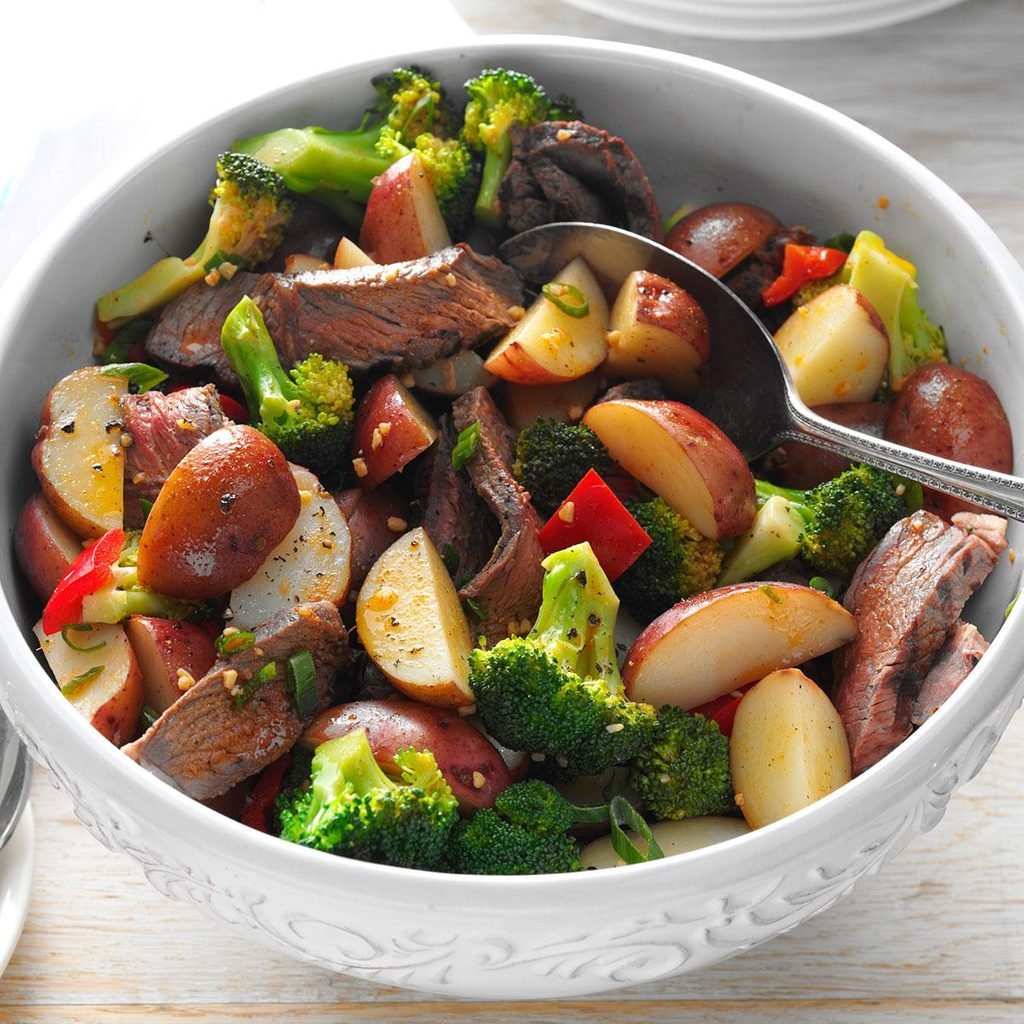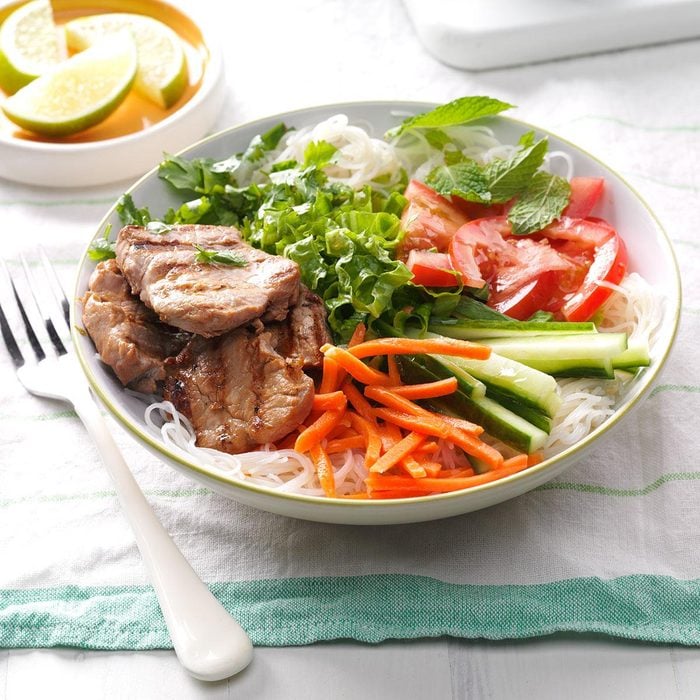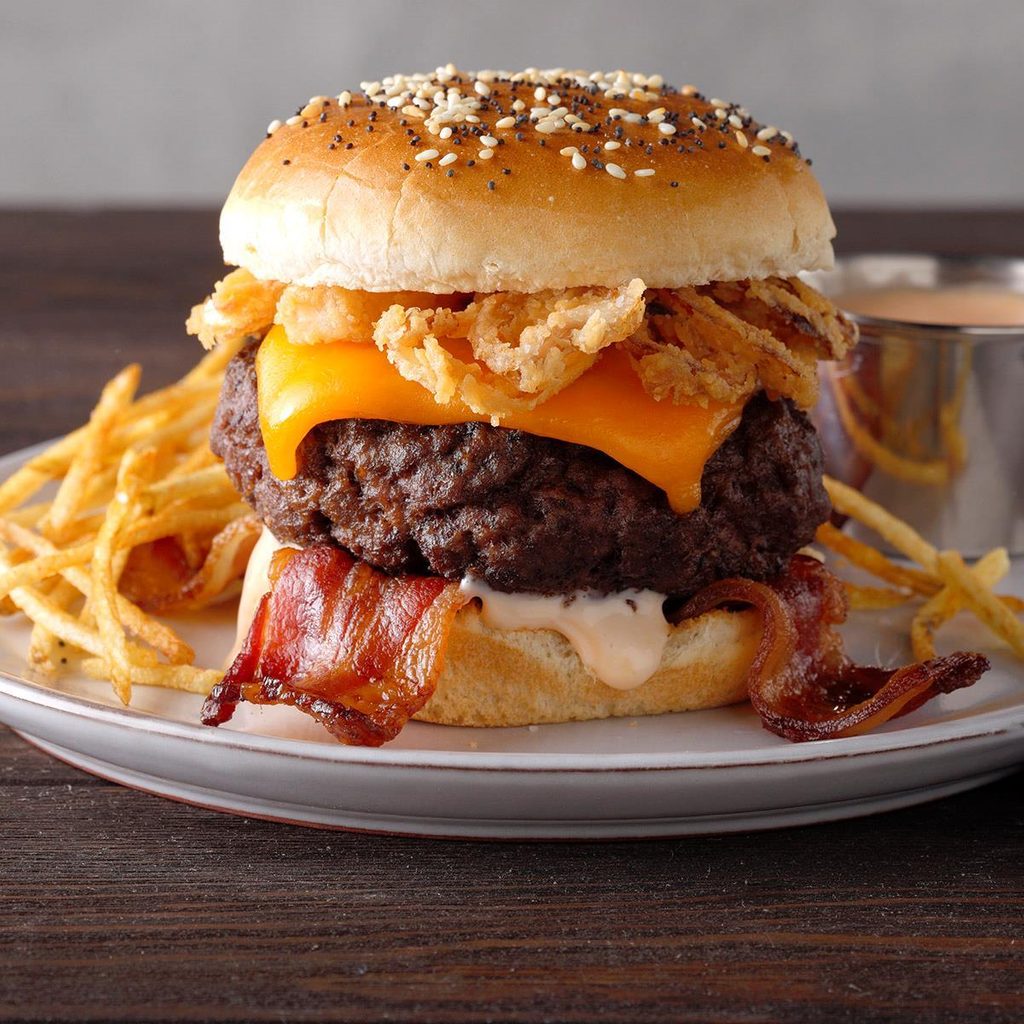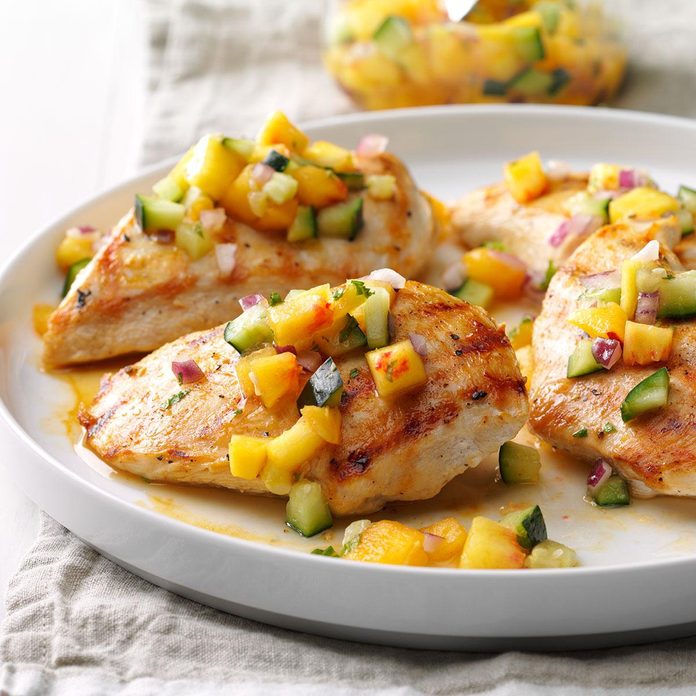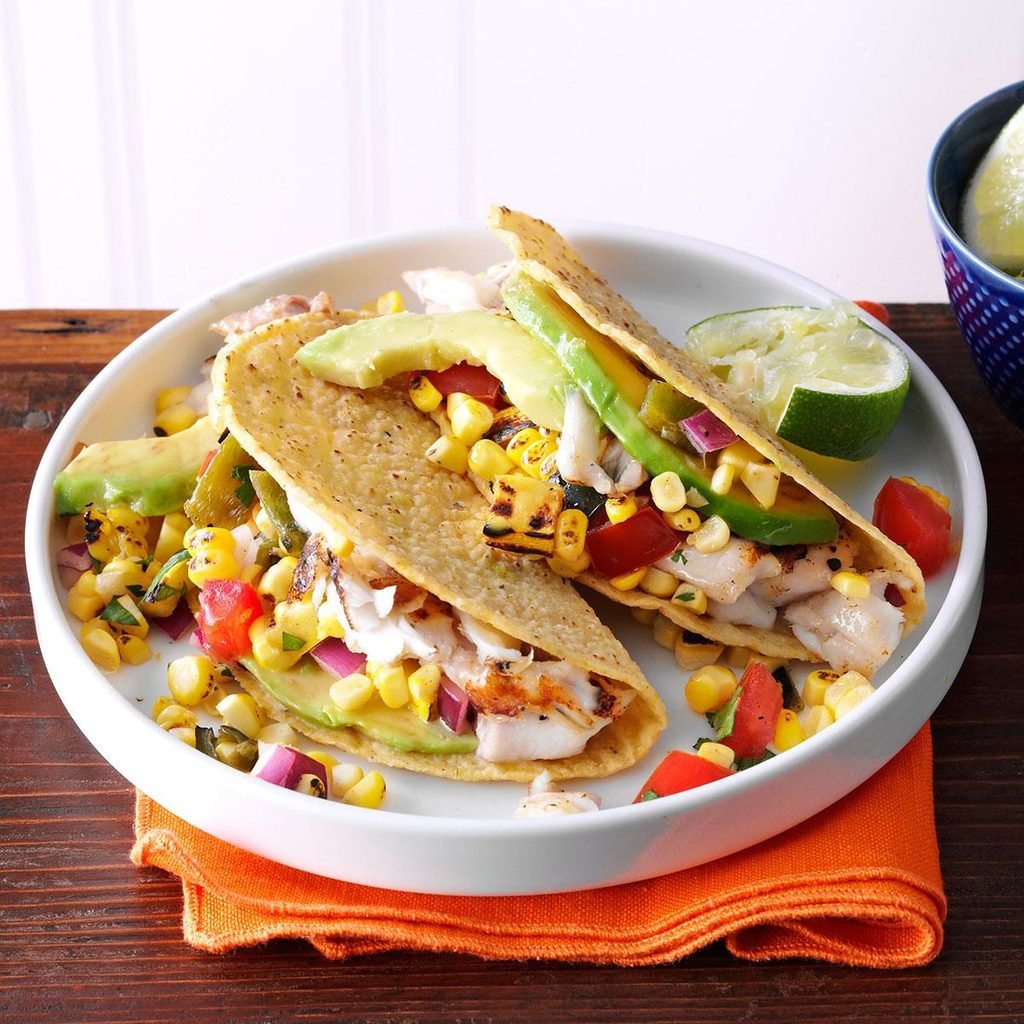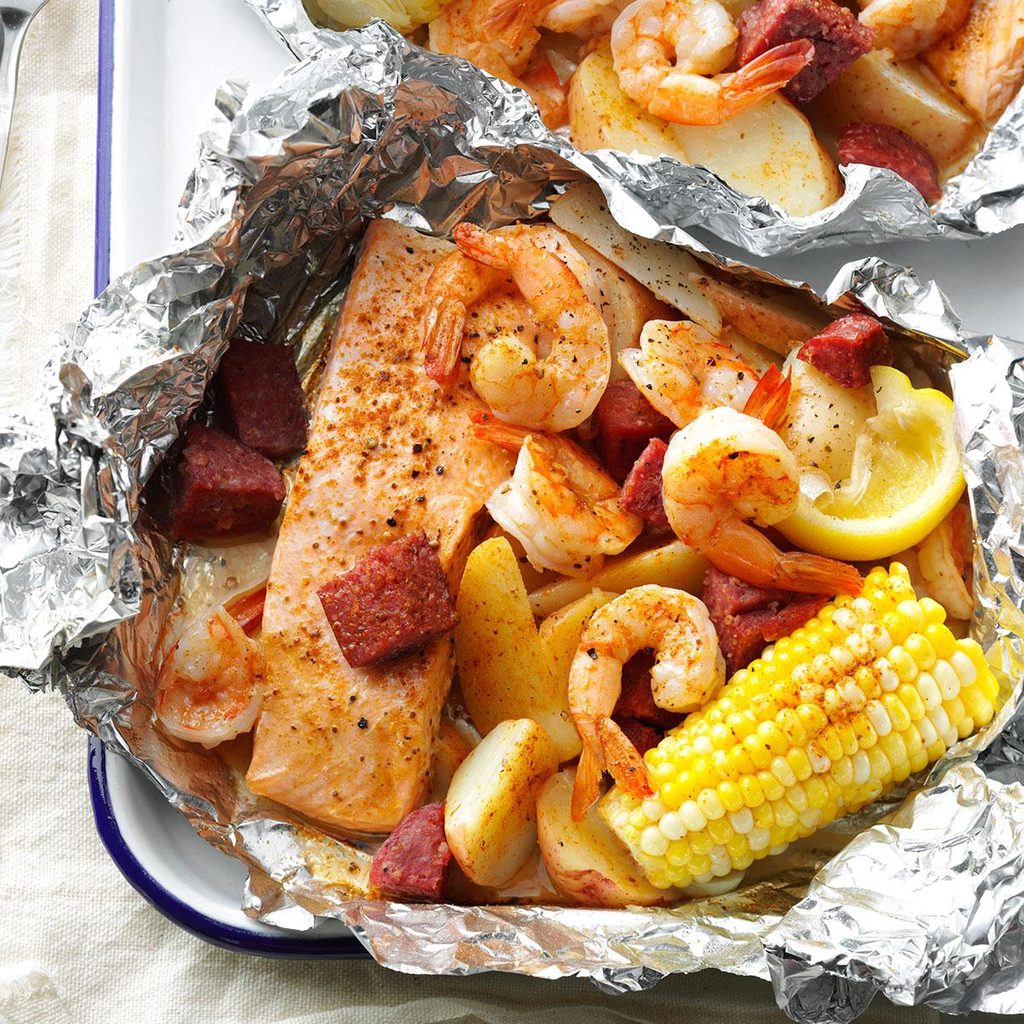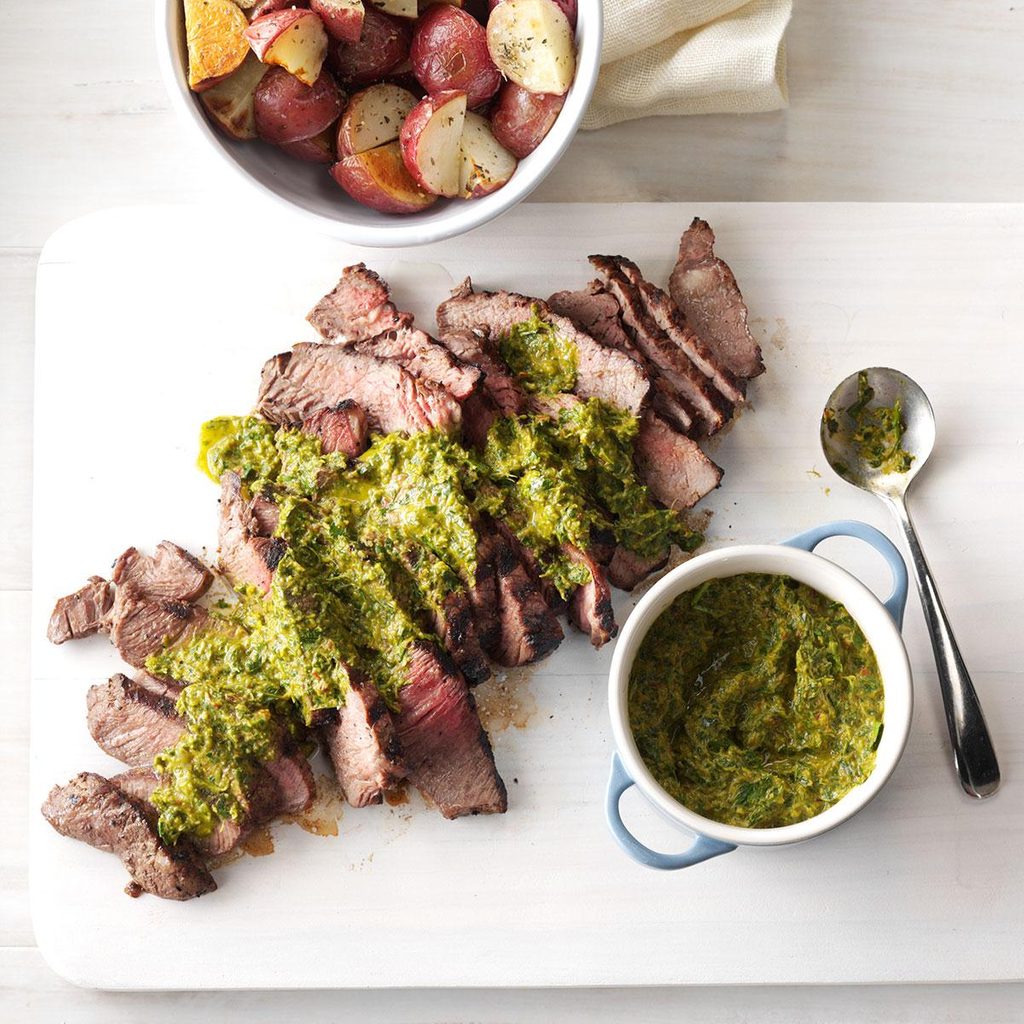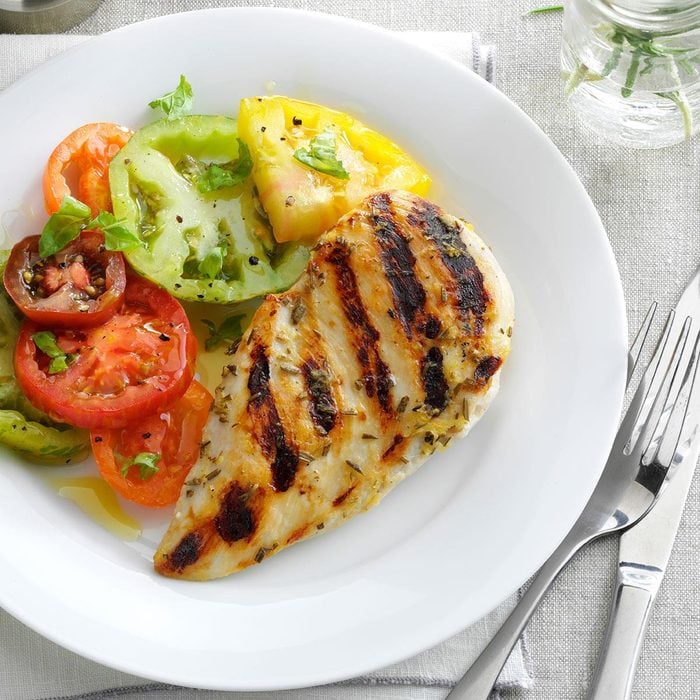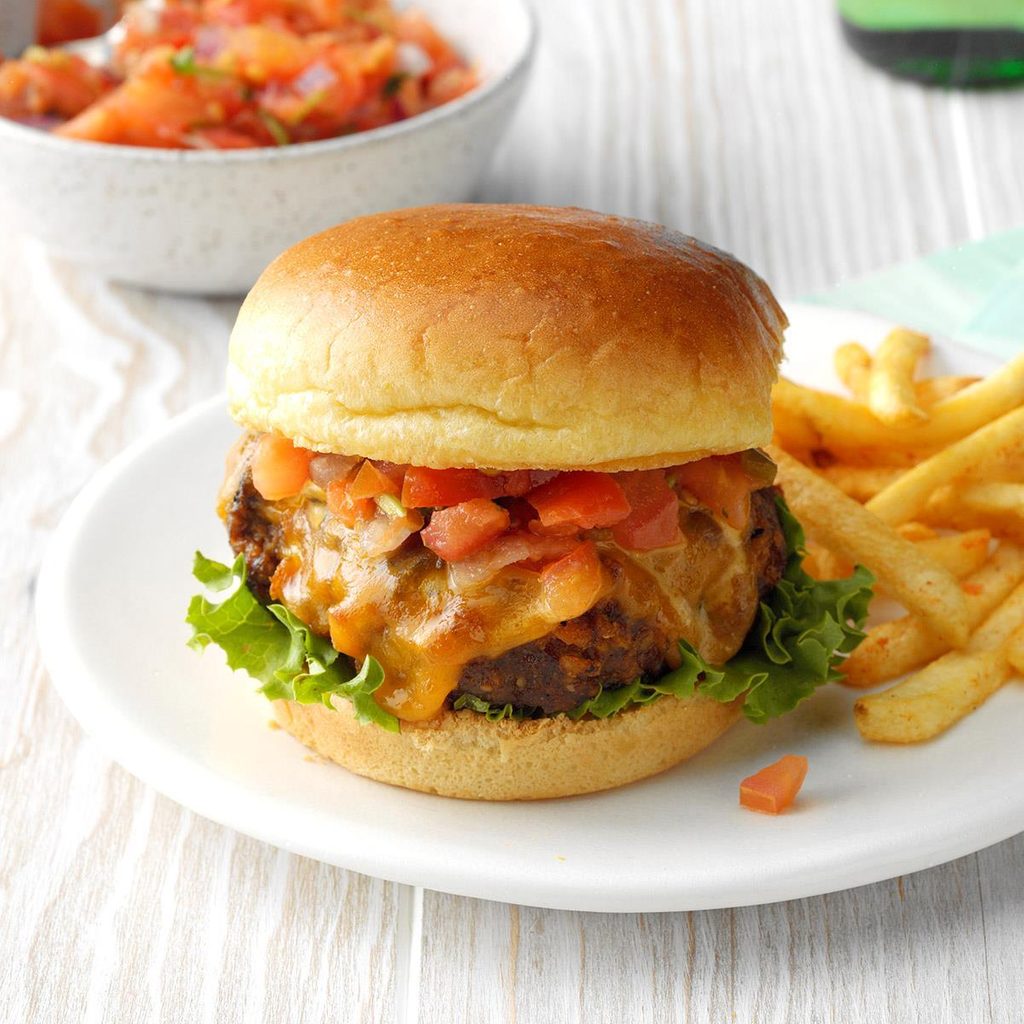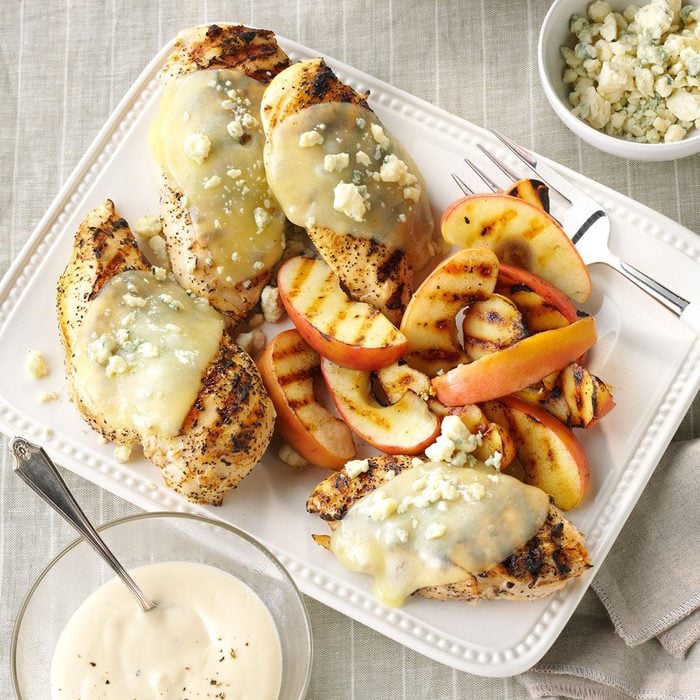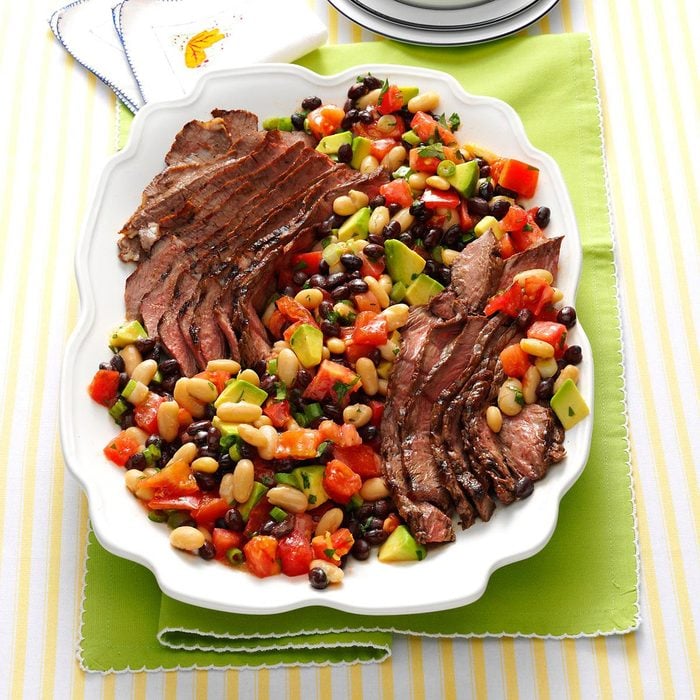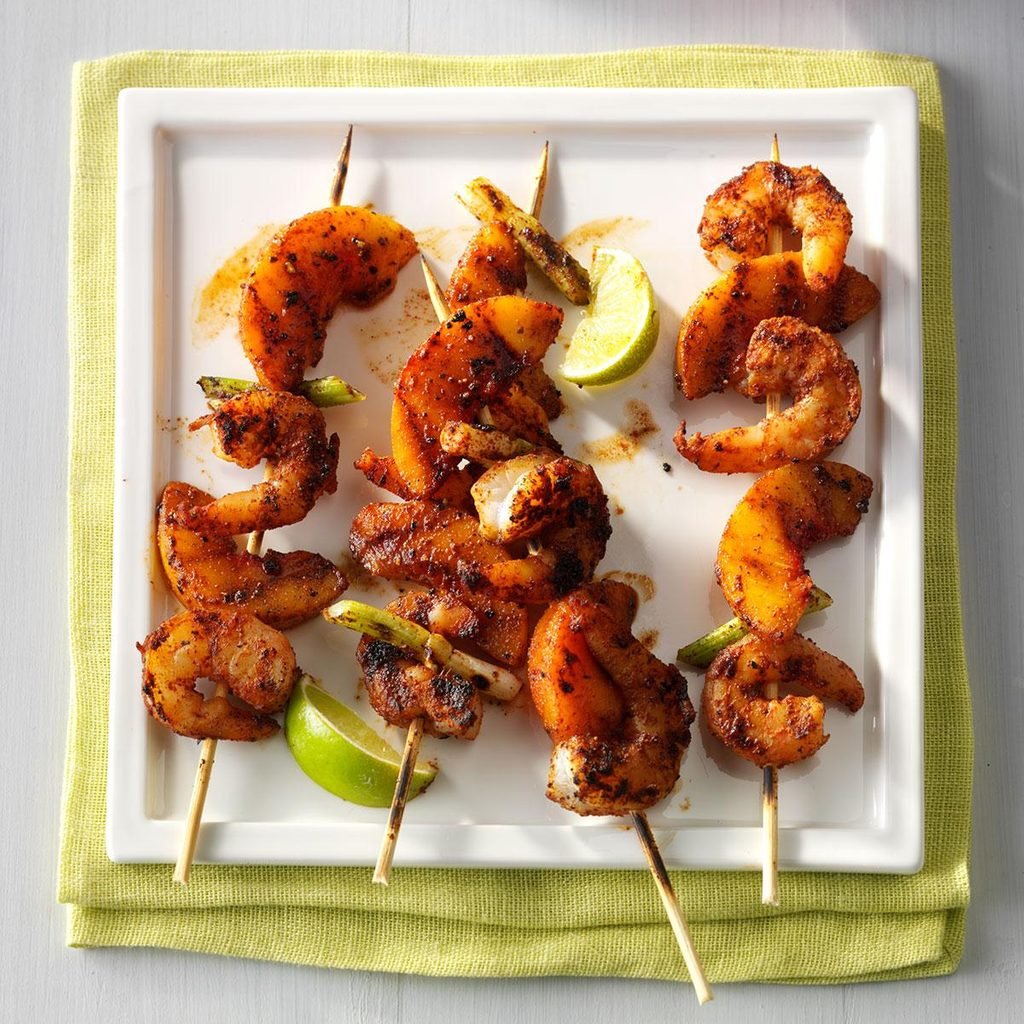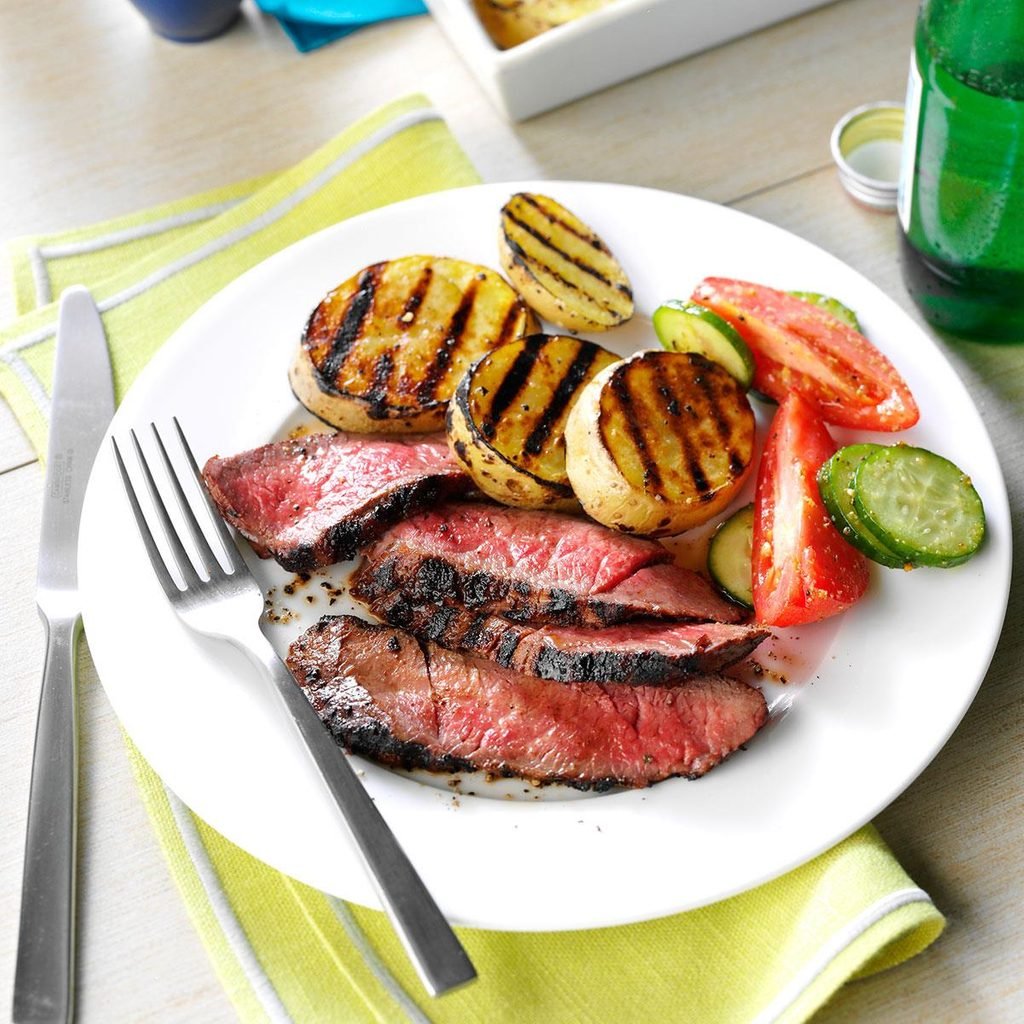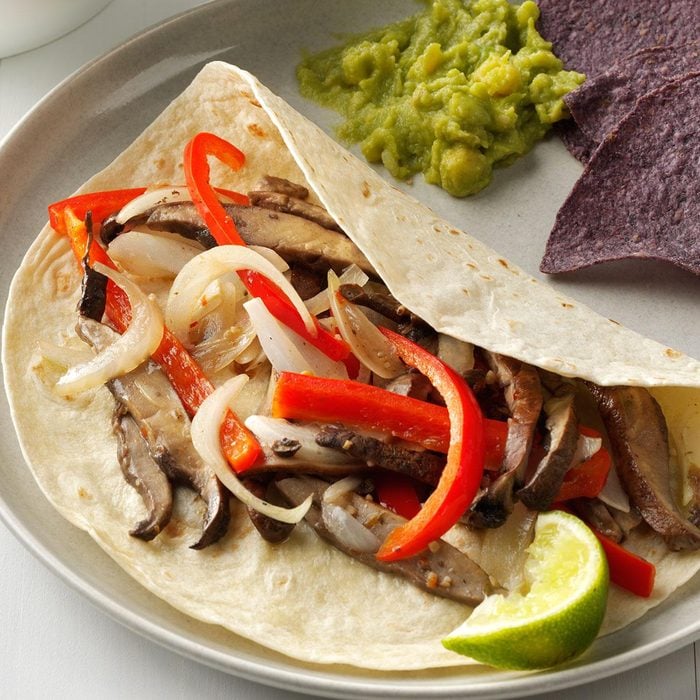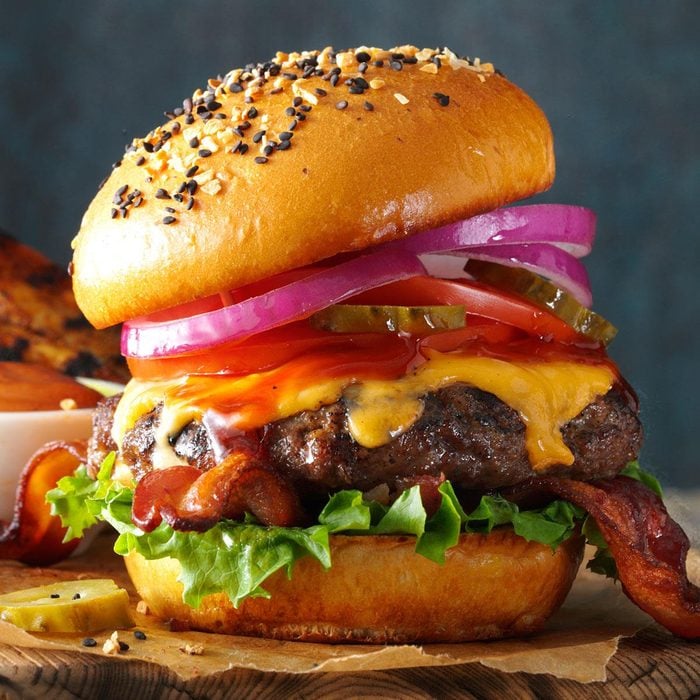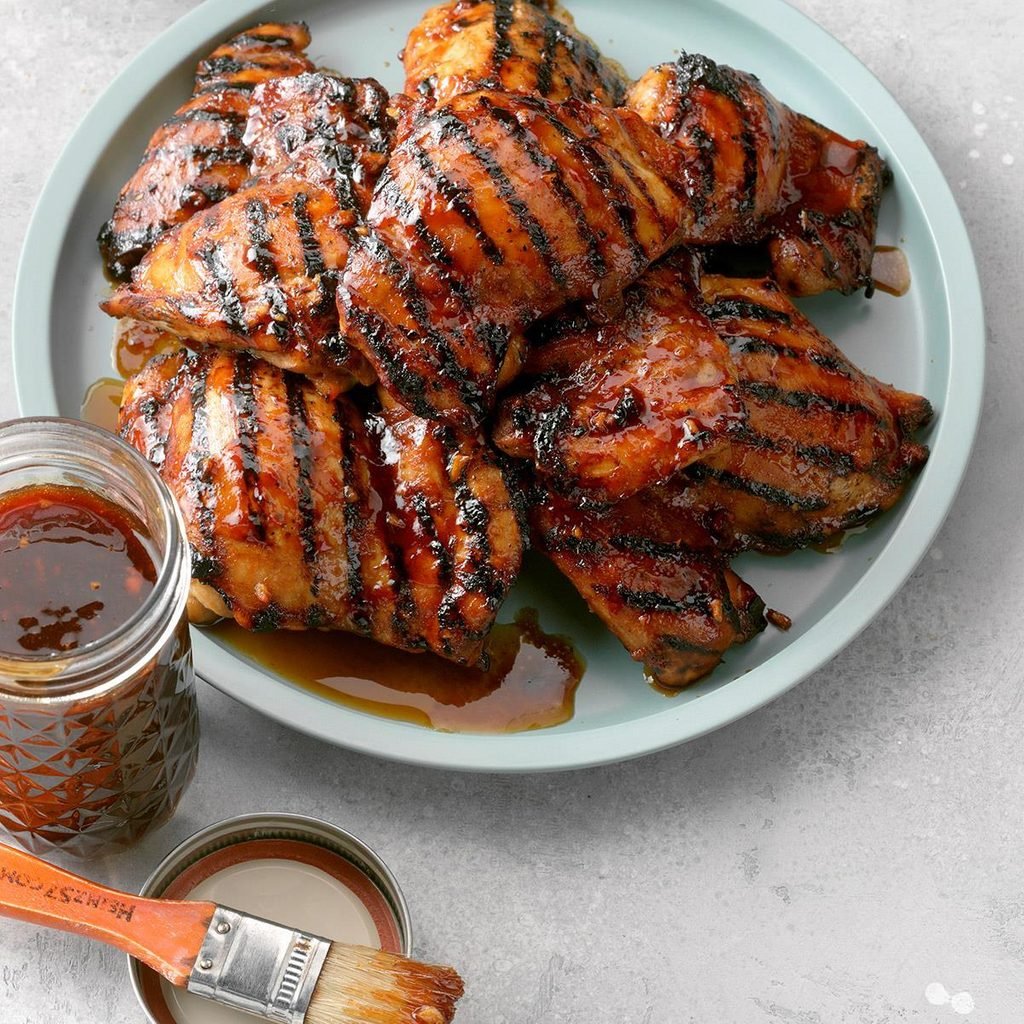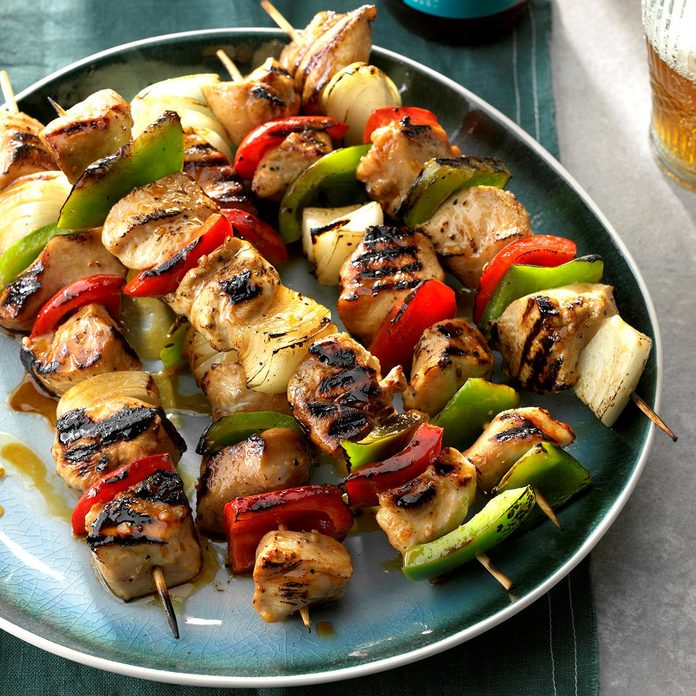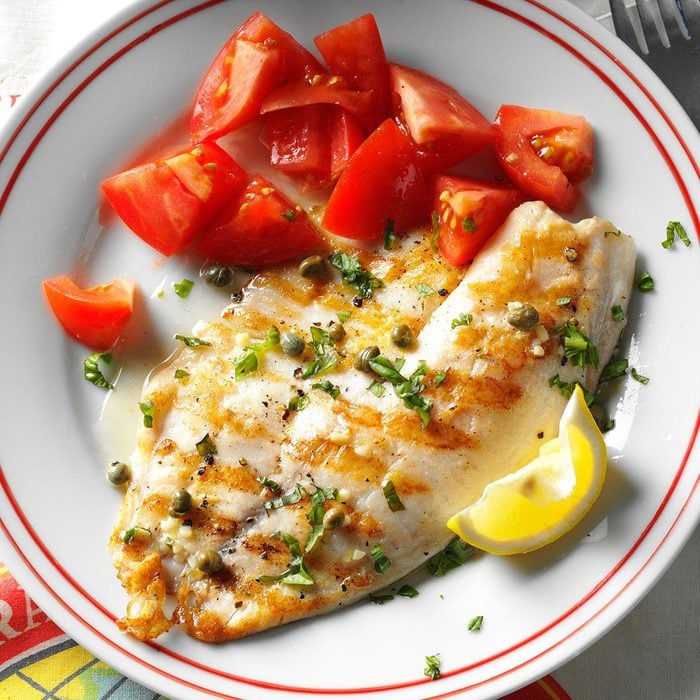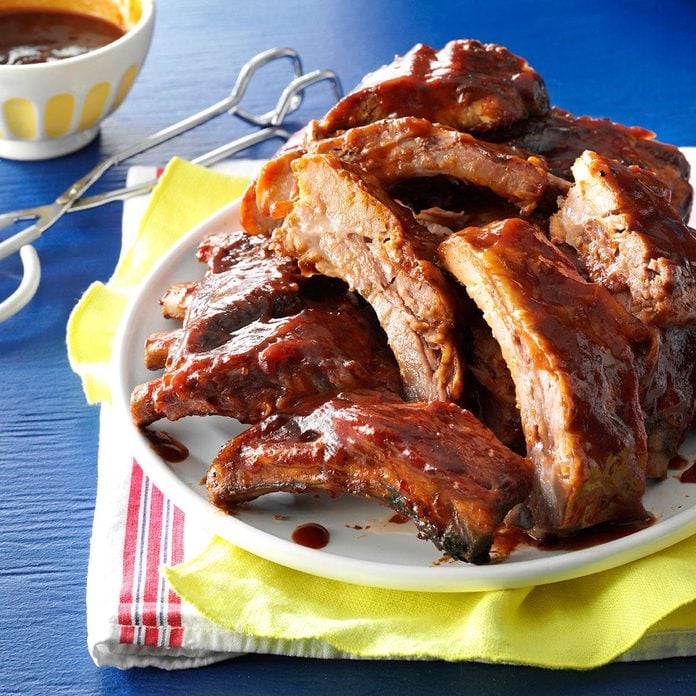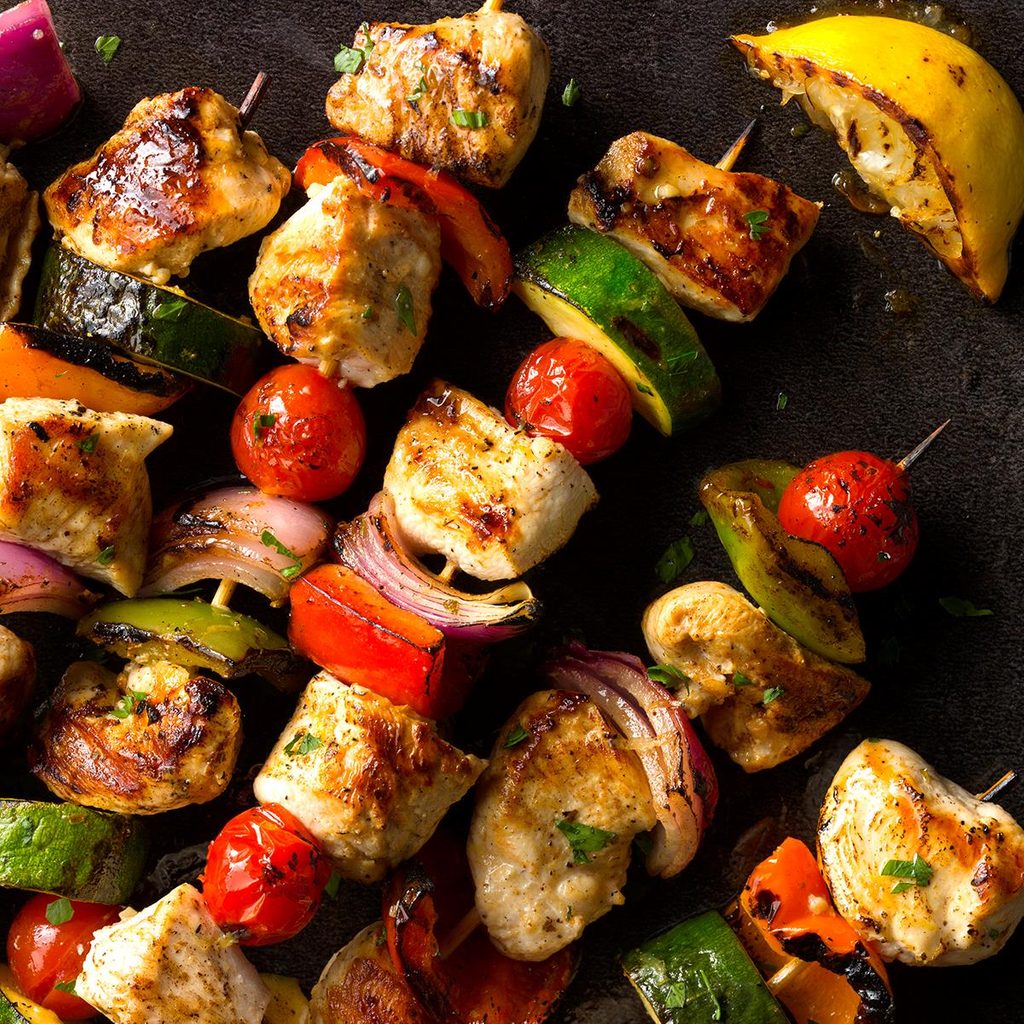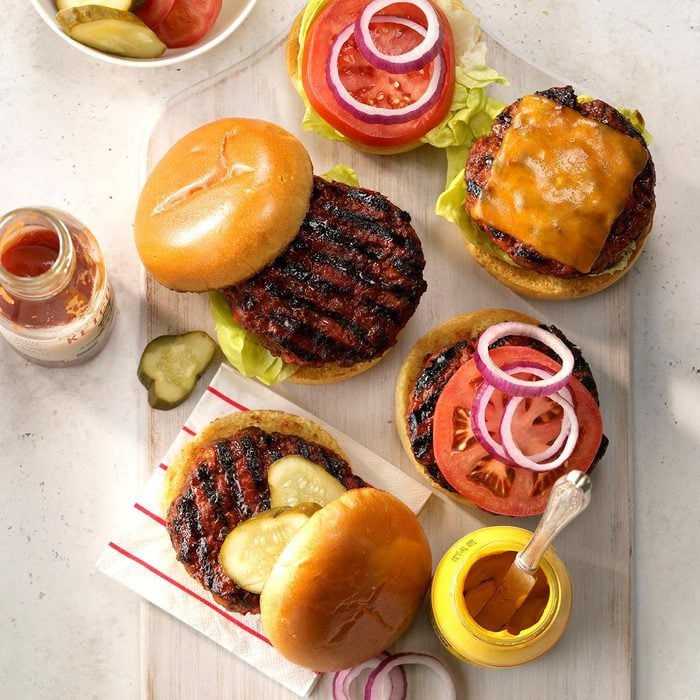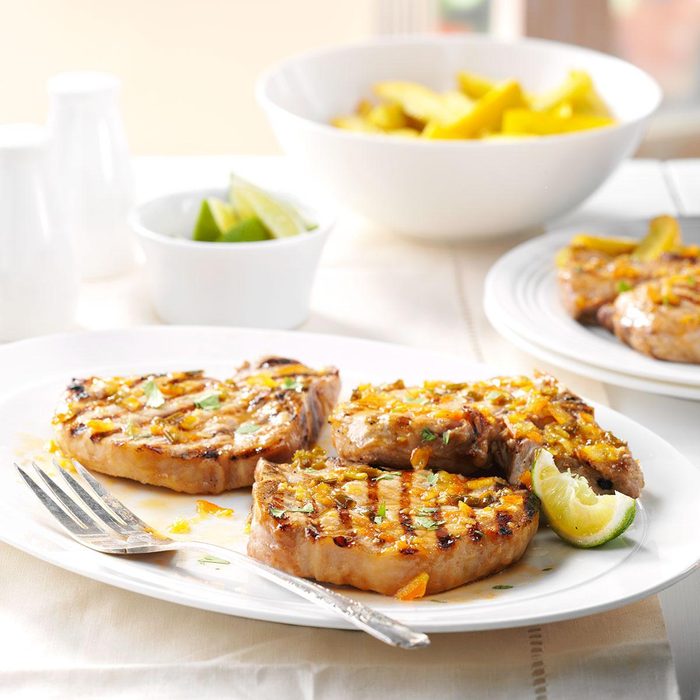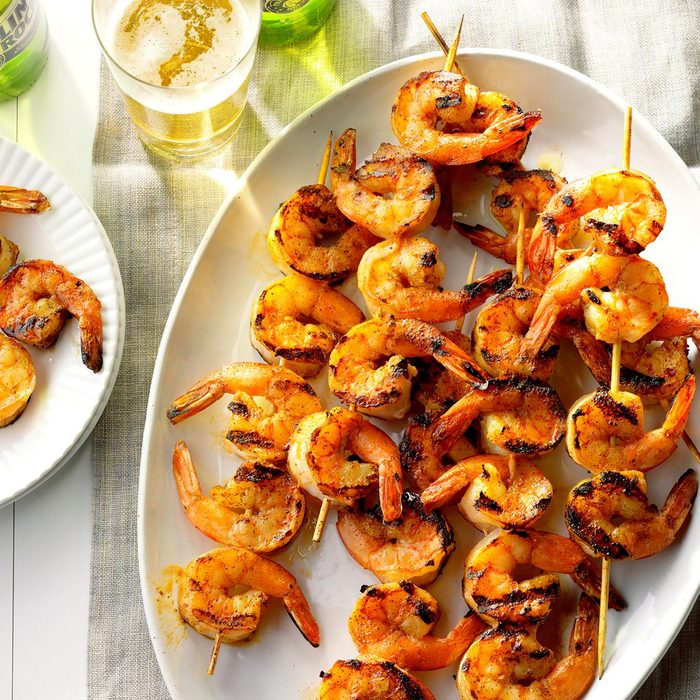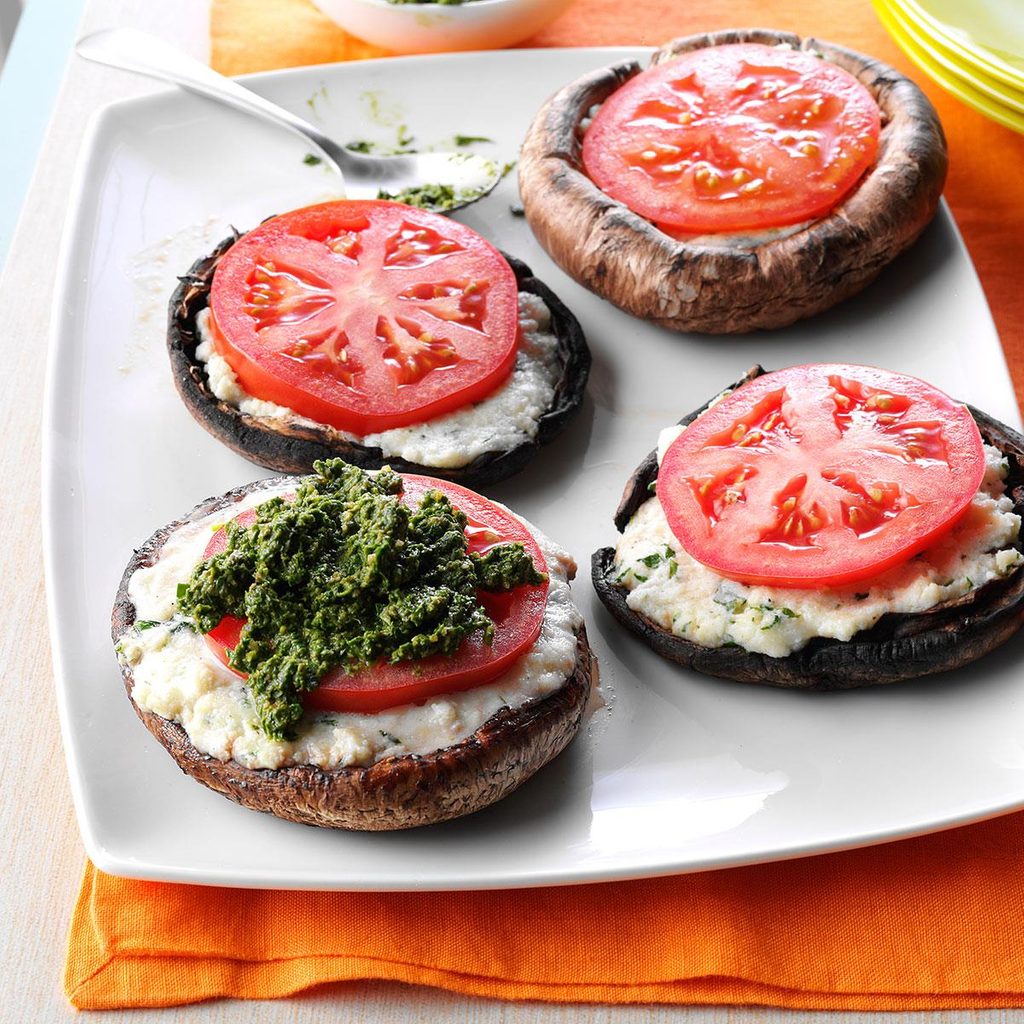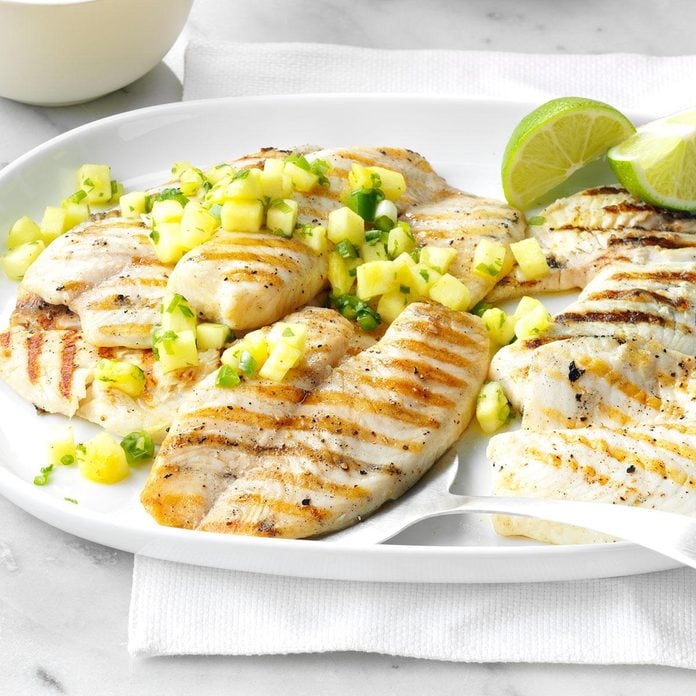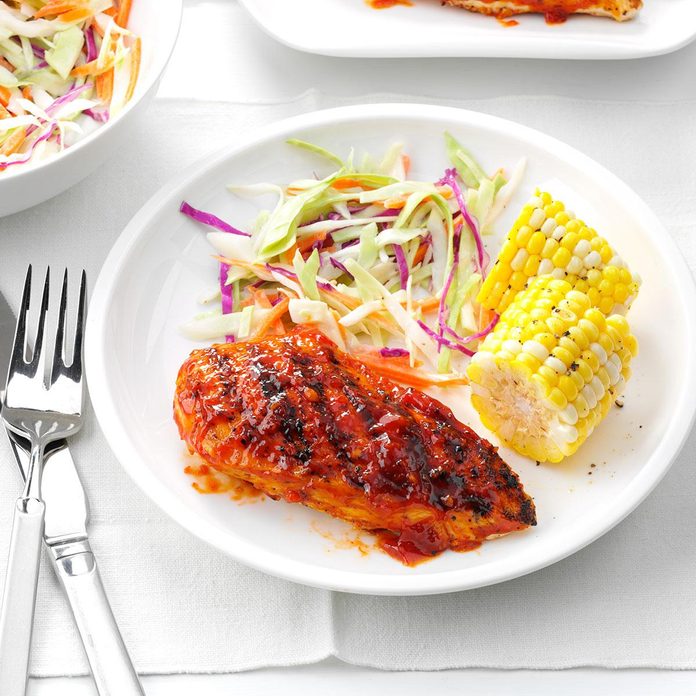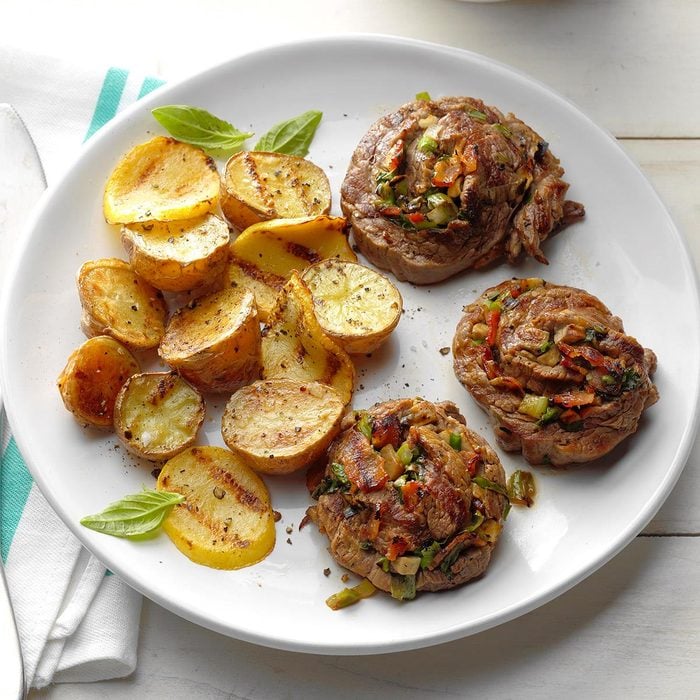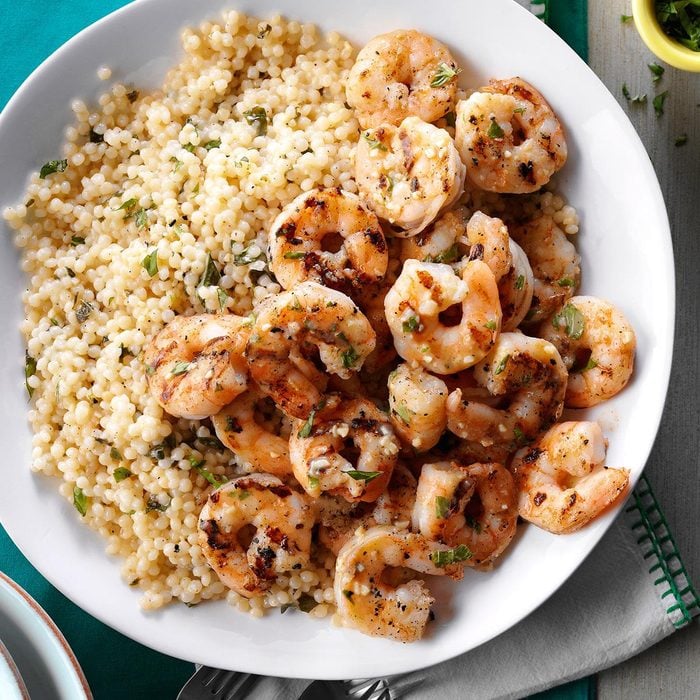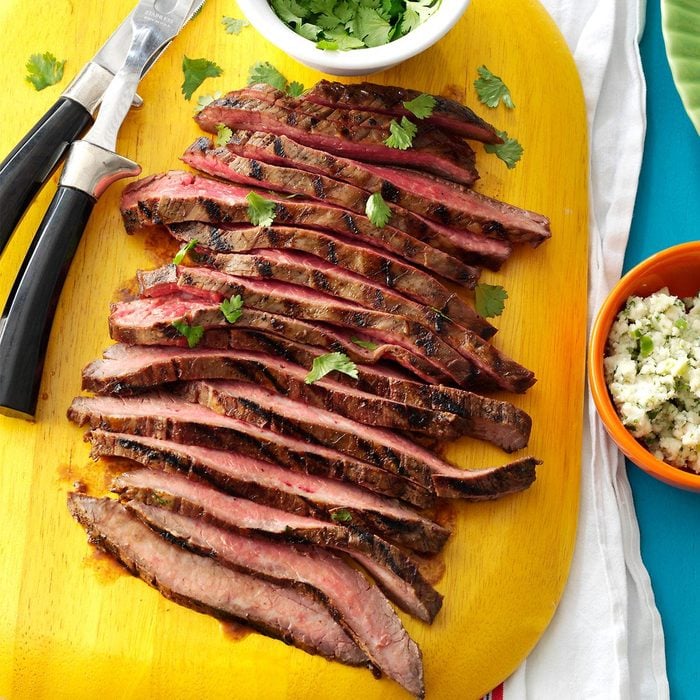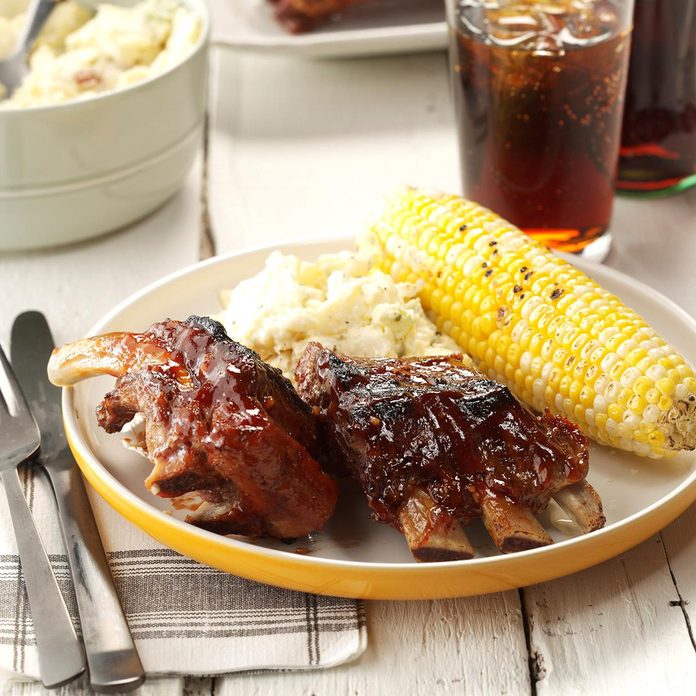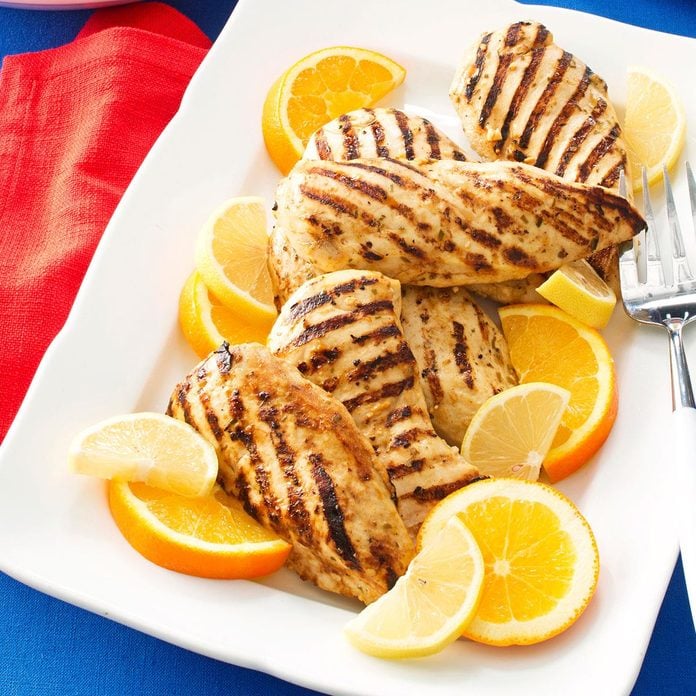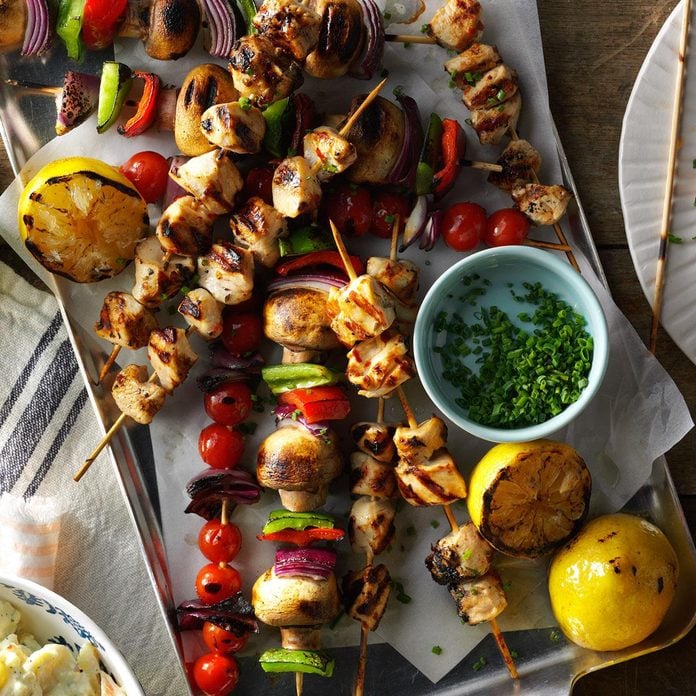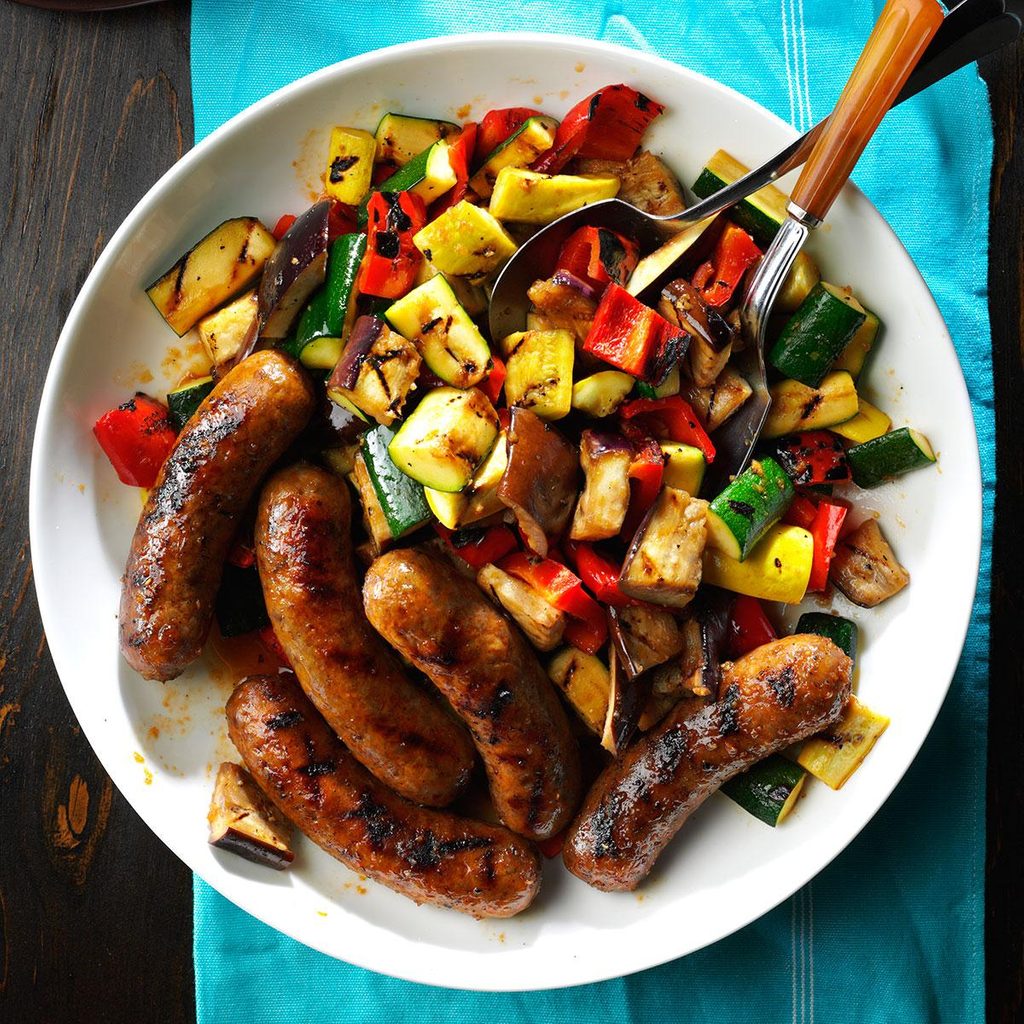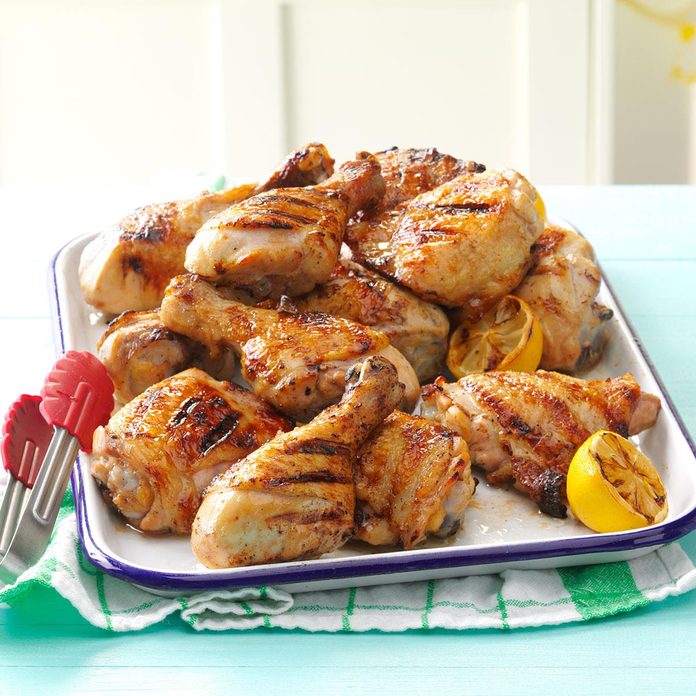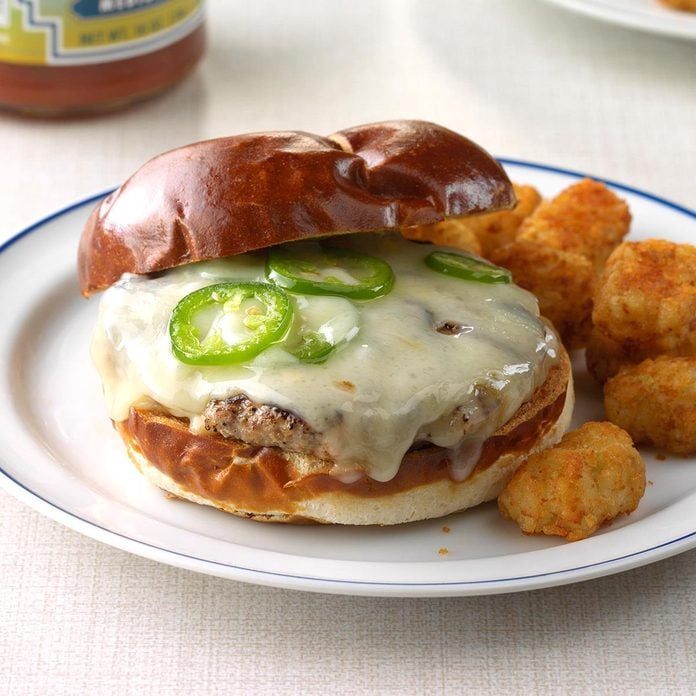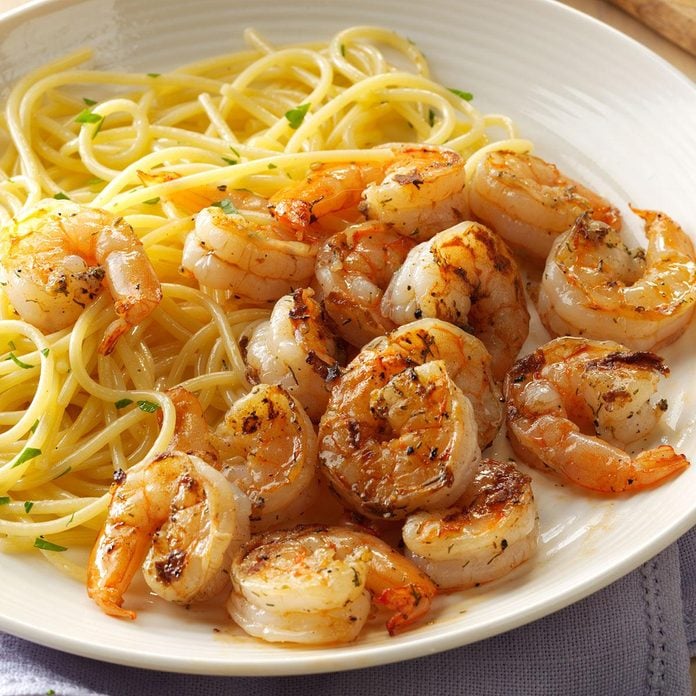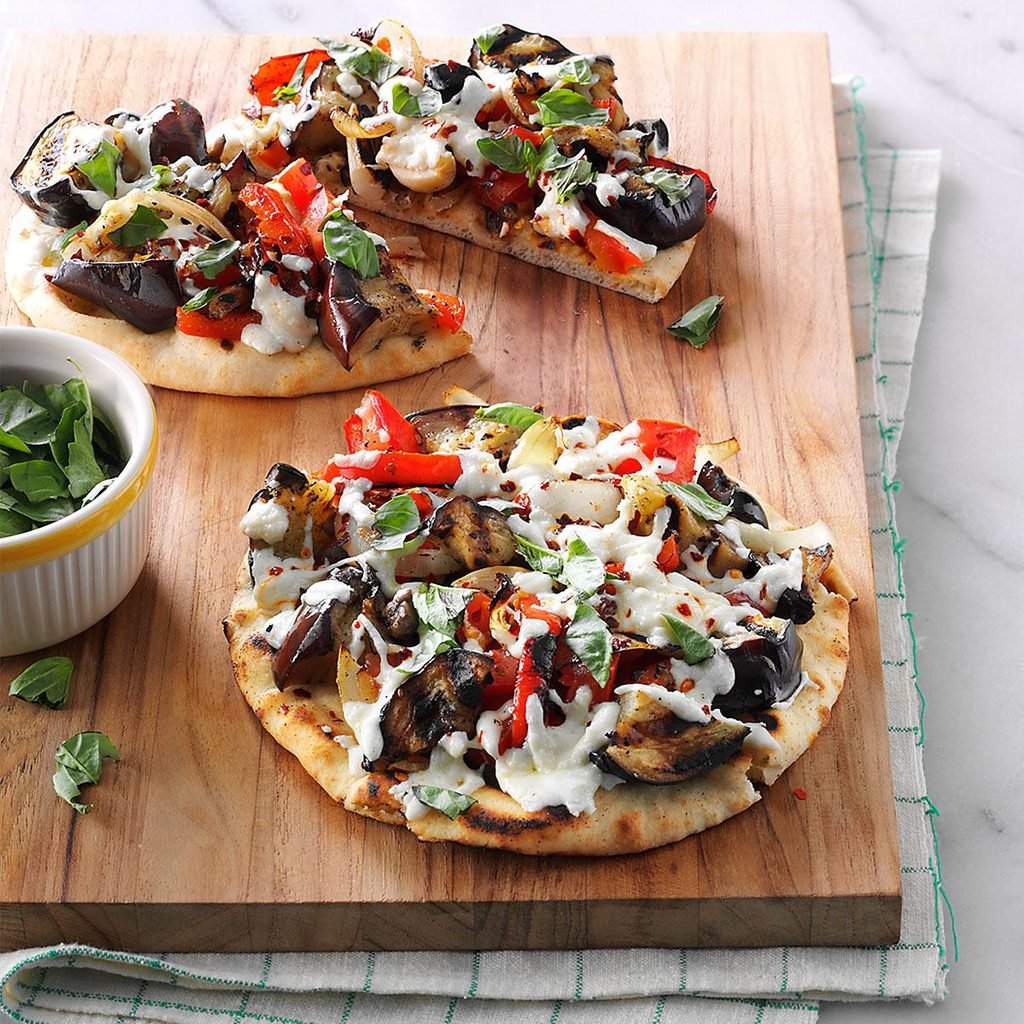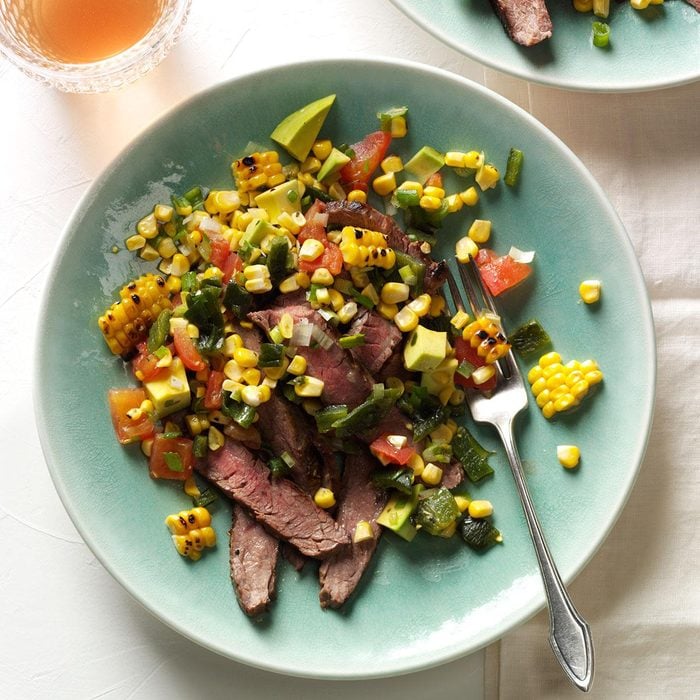Glazed Spatchcocked Chicken
A few pantry items inspired this recipe, which I've since made for small weeknight meals or for big parties. —James Schend, Pleasant Prairie, Wisconsin
Go to Recipe
Grilled Scrum-Delicious BurgersI'm not sure where this recipe originated, but it's one of my family's summertime favorites. I usually serve these juicy mushroom burgers when we have company. The guests rave about the flavorful cheesy topping. It's fun to serve a burger that's a little more special. —Wendy Sommers, West Chicago, Illinois
Big John's Chili-Rubbed Grilled RibsWhen my family thinks of summer grilling, it's ribs all the way. Our Asian-inspired recipe is a welcome change from the usual barbecue-sauce versions. —Ginger Sullivan, Cutler Bay, Florida
Don't make these
grilling safety mistakes.
Grilled Key West Flank SteakMy husband, Jason, is the cook in our family. This is his recipe, inspired by his Colombian roots and our visits to Key West. Sometimes we grill extra lime and onion slices alongside. Serve with sides of rice and fried plantains. —Gretchen Ospina, Columbia Heights, Minnesota
Grilled Brats with Sriracha MayoI am a Sriracha fanatic, so that’s what inspired this dish. You can boil the brats in your favorite beer to reduce the fat and give them flavor before grilling, or spread garlic butter on lightly toasted buns. —Quincie Ball, Olympia, Washington
Grilled Mahi MahiInstead of grilling the usual hamburgers or chicken breasts, prepare this grilled mahi mahi and reel in raves! —
Taste of Home Test Kitchen
Grilled Steak TacosSpicy aioli brings a zesty kick to steak tacos, and the ribeye is a nice upgrade from typical ground beef. Grab one and enjoy the burst of flavor in each bite! —Michael Compean, Los Angeles, California
Grilled Feta-Dill Chicken BurgersI found fresh ground chicken at the butcher and gave it a whirl on our new grill. The result is these saucy burgers. Everybody went nuts—including my sister-in-law, an amazing cook! —Wendy Boughton, Victoria, British Columbia
Smoked Honey-Peppercorn SalmonI found this recipe in an Alaska fishing guide. Now it's the only way we do salmon. The brine gives it a sweet caramelized coating, and the hickory wood chips give it a distinct smoky flavor. —Judy Ashby, Jamestown, Tennessee
Grilled Flank Steak PinwheelsThe secret to these pretty flank steak pinwheels lies in their butterfly treatment. Because the steaks are flattened, marinade isn’t need. Instead, they’re filled with a colorful stuffing of red pepper and spinach and draped with a flavorful, homemade blue cheese sauce. —Taste of Home Test Kitchen
Grilled Ginger Shrimp with PlumsSweet, simple and sensational, these shrimp skewers boast loads of flavor with just four ingredients. Throw them on the grill for a quick dinner or tasty potluck dish. —Taste of Home Test Kitchen
Spiced Grilled Chicken with Cilantro Lime ButterThis grilled chicken gets a lovely pop of color and flavor from the lime butter—don't skip it! —Diane Halferty, Corpus Christi, Texas
Grilled Foil-Packet Potatoes and SausageMy family enjoys camping and cooking over a fire. These hearty foil-packet potatoes turn out beautifully over a campfire, on the grill or in the oven at home. —Julie Koets, Elkhart, Indiana
Grilled Green Onion BurgersChange up this super tasty burger with your favorite toppings. Whip some mayo with hoisin sauce to add extra tang! —Darla Andrews, Schertz, Texas
Grilled Huli Huli Turkey DrumsticksI'm never one to do things traditionally, so when it came time to hosting Thanksgiving, I went in a completely tropical direction. Borrowing my favorite Hawaiian chicken recipe, I substituted turkey legs and have never looked back. —Jacyn Siebert, San Francisco, California
Lime and Dill Chimichurri ShrimpChimichurri is a very popular condiment in Argentina and Uruguay and is most often used as a dipping sauce or a marinade for meats. My chimichurri shrimp version incorporates dill and lime, which give it a brighter flavor, making it ideal for spring and summer entertaining. —Bonnie Landy, Castro Valley, California
Chicken with Peach-Avocado SalsaThis super fresh dinner is pure summer—juicy peaches, creamy avocado, grilled chicken and a kick of hot sauce and lime. To get it on the table even quicker, make the salsa ahead. —Shannon Roum, Cudahy, Wisconsin
Aloha BurgersI love hamburgers and tropical fruit, so it just seemed natural for me to combine them. My family frequently requests this unique Hawaiian pineapple burger recipe. It's a nice change of pace! —Joi McKim-Jones, Waikoloa, Hawaii
Grilled Lobster TailsI had never tried grilling lobster tails at home until I tried this convenient and deliciously different recipe. It turned out amazing, and has left me with little reason to ever order grilled lobster tail at a restaurant again. Here's how to cook lobster tails on the grill. —Katie Rush, Kansas City, Missouri
Steak FajitasZesty salsa and tender strips of steak make these traditional fajitas extra special. —Rebecca Baird, Salt Lake City, Utah
Grilled Shrimp & Tomatoes with LinguineThis pasta came about one night when I started making up dinner as I went along, using what I had on hand. We knew it turned out amazing with the very first bite. —Lisa Bynum, Brandon, Mississippi
Grilled Pineapple ChickenA trip to Hawaii is easy with this juicy grilled pineapple chicken. Simply give it a quick marinade, fire up the grill and let it sizzle. We love this low-carb recipe! —Charlotte Rogers, Virginia Beach, Virginia
Teriyaki Shish KabobsWhen I was a teenager, my father worked for an airline, and my family lived on the island of Guam in the South Pacific. A friend of my mother gave her this tangy-sweet recipe, and we enjoyed it often. Now I make it for my family, and they're big fans as well. —Suzanne Pelegrin, Ocala, Florida
Gourmet Burgers with Sun-Dried TomatoThis recipe brings together many of the flavors my family enjoys, complete with a surprise in the center of each burger. You can use almost any cheese—Gorgonzola, feta, smoked Gouda, blue or another family favorite. —Aaron Shields, Hamburg, New York
Balsamic Steak SaladMy husband loves blue cheese and I like a hearty salad that eats like a meal, so I put the two things together to make this steak salad recipe. The sweet-tartness of dried cranberries pairs deliciously with the cheese, creamy avocado and balsamic vinegar. It's irresistible! —Marla Clark, Albuquerque, New Mexico
Sesame Ginger Beef SkewersMy family loves the flavors of these zippy kabobs. They're perfect for a laid-back cookout in the backyard. —Jasey McBurnett, Rock Springs, Wyoming
Papa BurgerWhen whipping up something for Father’s Day or the Fourth of July, I go big and tall with this fully loaded, juicy yumburger. —Chase Bailey, Costa Mesa, California
Firecracker Grilled SalmonLet this sensational firecracker salmon perk up dinner tonight. With a super flavorful glaze that kicks you right in the taste buds, this weeknight dish is anything but boring. —Melissa Rogers, Tuscaloosa, AL
Steak & New Potato TossI usually use leftover barbecued steak to make this fabulous main dish salad. It's pretty, too, with the red pepper, green broccoli and white potatoes. —Deyanne Davies, Rossland, British Columbia
Grilled Pork Noodle SaladThe only complex thing about this easy salad is the flavor! With smoky barbecued pork and a variety of fresh herbs and vegetables, this is a comforting and tasty home-cooked meal. —Rosalyn Nguyen, Astoria, New York
Bacon Cheeseburgers with Fry SauceIn Utah, fry sauce is a beloved condiment. We use it not just as a dip for fries, but also as a spread for hamburgers. Utah is known as the Beehive State, so I added honey as a special touch to my fry sauce. —Elisabeth Larsen, Pleasant Grove, Utah
Chicken with Peach-Cucumber SalsaTo keep our kitchen cool, we grill chicken outdoors and serve it with a minty peach salsa that can easily be made ahead. —Janie Colle, Hutchinson, Kansas
Summer Garden Fish TacosI like to serve fish tacos with quinoa and black beans for a complete and satisfying meal. If you’ve got them, add colorful summer toppings like bright peppers, green onions or purple carrots. —Camille Parker, Chicago, Illinois
Cajun Boil on the GrillI came up with these everything-in-one seafood packets for a family reunion, since the recipe can be increased to feed a bunch. The foil steams up inside, so open carefully. —Allison Brooks, Fort Collins, Colorado
Steak with Chipotle-Lime ChimichurriSteak gets a flavor kick from chimichurri. This piquant, all-purpose herb sauce is so versatile, it complements most any grilled meat, poultry or fish. —Laureen Pittman, Riverside, California
Rosemary-Lemon Grilled ChickenHere's a simple dish with big bold lemon and rosemary flavors that's made with very few ingredients. It's great by itself but can also be used on top of salad greens as another creative dinner option. —Debbie Carter, Kingsburg, California
Taco BurgersMy family loves the taste of tacos, but I dislike the mess! So I developed these burgers as a tasty but tidy alternative.—Linda Logan, Warren, Ohio
Chicken Alfredo with Grilled ApplesIf you've never grilled apples before, here's your excuse to start. I created this Alfredo-style chicken for a party. By the number of recipe requests, I knew it was a hit. —Richard Robinson, Park Forest, Illinois
Grilled Steak Salad with Tomatoes & AvocadoMy family loves a good steak dinner, but with busy schedules, I'm often thinking about ways to put new and simple twists on things. This salad is flavored with the freshness of lemon and cilantro and is one of my husband's favorite weeknight dishes. —Lyndsay Wells, Ladysmith, British Columbia
Barbecued Shrimp & Peach KabobsShrimp grilled with peaches and green onions really sets off fireworks! The spicy seasonings even helped me win a ribbon at a county fair. —Jen Smallwood, Portsmouth, Virginia
Southwest Steak & PotatoesBold seasonings give meat and potatoes a Southwest twist. Feel free to adjust the heat factor by using more or less chili powder. —Kenny Fisher, Lancaster, Ohio
Portobello FajitasI serve portobello fajitas family-style so guests can build their own. Just pass the tortillas and garnishes like salsa, cheese, guacamole and sour cream. —Carolyn Butterfield, Lake Stevens, Washington
Barbecued BurgersI can't take all the credit for these winning burgers. My husband's uncle passed down the special barbecue sauce recipe. We love it on everything...it was only natural to try it on, and in, burgers. Add cheese and bacon to take them over the top. —Rhoda Troyer, Glenford, Ohio
Ginger Halibut with Brussels SproutsI moved to the United States from Russia and love cooking Russian food for family and friends. Halibut with soy sauce, ginger and pepper is a favorite. —Margarita Parker, New Bern, North Carolina
Grilled Huli Huli ChickenI got this grilled chicken recipe from a friend while living in Hawaii. It sizzles with the flavors of brown sugar, ginger and soy sauce.
Huli means "turn" in Hawaiian. This sweet and savory glaze is fantastic on pork chops, too. —Sharon Boling, San Diego, California
Honey-Glazed Chicken KabobsThis is my husband’s favorite "special day" meal. I serve it with rice pilaf, salad and grilled garlic bread. —Tracey Miller, Aiken, South Carolina
Grilled Tilapia PiccataWe aren’t big fish eaters, but a friend made this for us, and we couldn’t believe how wonderful it was! Now we eat it regularly. I love making it for guests because it’s simple, looks lovely and tastes restaurant-worthy. —Beth Cooper, Columbus, Ohio
Honey Chipotle RibsNothing is better than having a sauce with the perfect slather consistency. Here's one that will ensure a lip-smacking feast. Go ahead and make the sauce up to a week ahead for an easier grilling experience. —Caitlin Hawes, Westwood, Massachusetts
Lemon Chicken SkewersChicken skewers with tender chunks of chicken and garden-fresh veggies are easy to assemble and are always a hit at parties. —Margaret Allen, Abingdon, Virginia
Cola BurgersA friend who's an excellent cook shared this hamburger recipe with me, and it has since become a family favorite. The unusual combination of cola and French salad dressing added to the ground beef gives it fabulous flavor. The mixture is also used as a basting sauce on the moist burgers.
-Melva Baumer, Millmont, Pennsylvania
Lime-Glazed Pork ChopsThese tangy grilled chops are all the talk at barbecues and tailgates. You gotta have them with the sweet and sour glaze. —Jacqueline Correa, Landing, New Jersey
Summer Steak KabobsThese steak kabobs not only satisfy my love of outdoor cooking, they feature a mouthwatering marinade, too. It's terrific with chicken and pork, but I prefer it with beef because it tenderizes remarkably well. —Christi Ross, Guthrie, Texas
Buttery Grilled ShrimpThis grilled shrimp recipe is easy and delicious! These shrimp are great with steak, but for a special occasion, brush the sauce on lobster tails and grill. —Sheryl Shenberger, Albuquerque, New Mexico
Ricotta-Stuffed Portobello MushroomsThese mushrooms are rich and creamy and bright at the same time because of the fresh herbs and tomato. I especially like to serve them with grilled asparagus. —Tre Balchowsky, Sausalito, California
Grilled Tilapia with Pineapple SalsaYears ago I found a grilled tilapia recipe in a seafood cookbook. The pineapple salsa with cilantro has a touch of spice and goes so well with the flaky, tender fish. —Beth Fleming, Downers Grove, Illinois
Spicy Barbecued ChickenThis spicy, saucy chicken is great served with basil-buttered grilled corn on the cob and fresh coleslaw. —Rita Wintrode, Corryton, Tennessee
Grilled Steak PinwheelsI've been serving this recipe to family and friends for 20 years and very seldom do I have any leftovers. We try to keep the house cool, so we grill out often. —Mary Hills, Scottsdale, Arizona
Lemon-Basil Grilled Shrimp & CouscousThe basil and lemon in this dish complement each other so nicely. Using fresh ingredients really makes a big difference. —Trisha Kruse, Eagle, Idaho
Flank Steak with Cilantro & Blue Cheese ButterI love the combination of the sweet citrus marinade and the strong tang of the blue cheese butter. And my kids just love flank steak. —Gwen Wedel, Augusta, Michigan
Baby Back RibsSlow-cook the ribs during the day and they will be ready to finish on the grill when you get home. —Taste of Home Test Kitchen
Citrus-Marinated ChickenThis juicy, zesty chicken stars in many of my family’s summer meals. While there are a million ways to dress up poultry, you’ll find yourself turning to this recipe again and again. It’s that quick and easy! —Deborah Gretzinger, Green Bay, Wisconsin
Spicy Lemon Chicken KabobsWhen I see Meyer lemons in the store, it must be spring. I like using them for these easy chicken kabobs, but regular grilled lemons still add the signature smoky tang. —Terri Crandall, Gardnerville, Nevada
Grilled Sausages with Summer VegetablesAfter 30 years of camping, we've come up with an arsenal of surefire recipes. Our grilled sausage with veggies would be a superstar at a potluck. —Nancy Daugherty, Cortland, Ohio
Dad's Lemony Grilled ChickenLemon juice, onions and garlic add tangy flavor to chicken when firing up the grill. —Mike Schulz, Tawas City, Michigan
Jalapeno-Swiss Turkey BurgersThese easy turkey burgers are extra juicy and loaded with flavor. I think the spicy jalapenos give it just the right level of heat, but feel free to adjust the amount to amp it up or tone it down. —Wanda Allende, Orlando, Florida
Grilled Lemon-Dill ShrimpThis grilled shrimp is one of my go-to recipes when I stare at the freezer and draw a blank. Add veggies if desired, but grill them separately. —Jane Whittaker, Pensacola, Florida
Grilled Eggplant Pita PizzasWe grow eggplants and love to use them for our special pizza. Grilling adds robust flavor to the crust, veggies and garlic. Waiting for the eggplants to grow is the hardest part! —Judy Barrett, Chelsea, Alabama
Grilled Flank Steak with Summer RelishMy garden produces a nice harvest of tomatoes, scallions, corn, garlic and poblanos, so that's what I use to make relish for this tasty steak. —Brenda Washnock, Negaunee, Michigan
